
Home » Travel » Destinations » Savor the Journey: 7 Places to Visit Between Tokyo and Kyoto

Savor the Journey: 7 Places to Visit Between Tokyo and Kyoto
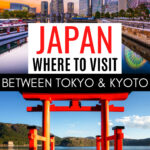
There are two kinds of people who visit Japan: those who speed along the Golden Route, and those who know where to slow down.
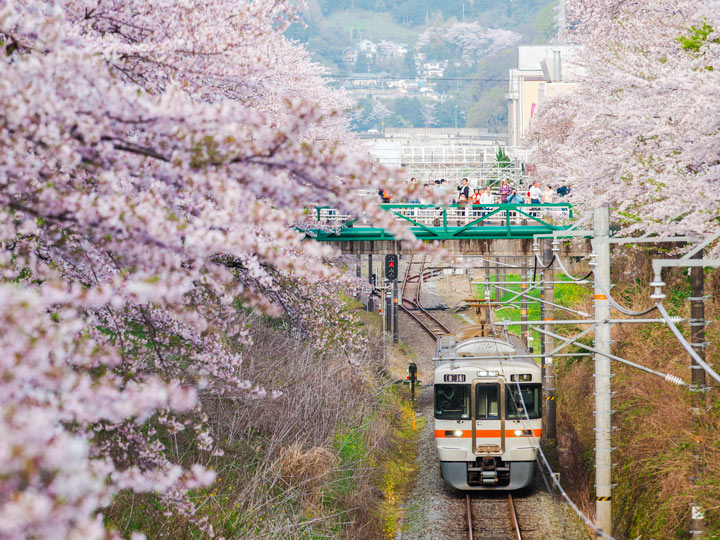
Now, I can empathize with people who want to see all the famous things in a week. Vacation time is precious, and not everyone can afford repeat trips to Japan. But there are so many places to visit between Tokyo and Kyoto that deserve to be on your itinerary.
This post contains affiliate links. As an Amazon Associate, I earn from qualifying purchases. For more information, click here .
Aside from Hakone, all of these cities lie directly on the Tokaido Shinkansen line that connects Tokyo to Osaka. And if you have a Japan Rail Pass , you can visit as many as you want for free!
From the renowned hot springs of Atami to the impressive Nagoya Castle, each destination has a unique highlight to enrich your Japan experience. Even if you only make time for a single stopover, I promise you won’t regret savoring your journey from Kyoto to Tokyo!
Don’t Forget Your Japan Rail Pass!
Buying a Japan Rail Pass will save you a ton of time and money when traveling across Japan.
I’ve purchased a JR pass for two out of three Japan trips, and here’s why:
– Free bullet trains and reservations : Quickly travel all over Japan to maximize vacation time.
– Easy to use: Just show your pass to the gate attendant and walk to your train!
– Affordable day trips: Visit popular places like Nagoya, Kanazawa, and more without spending a fortune on tickets.
Order your Japan Rail Pass now for speedy delivery!
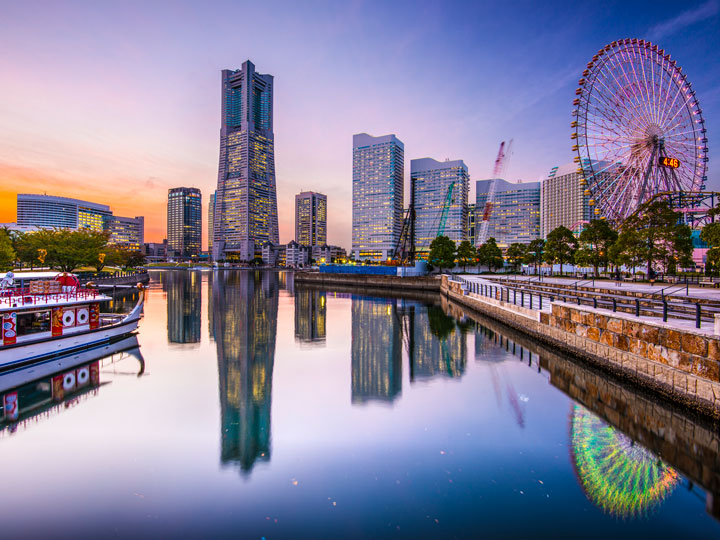
Located just one stop south of Tokyo, Yokohama is a bustling and vibrant coastal city with a ton of sightseeing spots. Although it’s one of Japan’s largest cities, most of the highlights are concentrated along the eastern coast and can be seen in a day.
The waterfront Minato Mirai district is especially popular with visitors. You can soak up panoramic views on the iconic Cosmo Clock 21 , one of the world’s tallest ferris wheels, or the Landmark Tower Sky Garden . For a more down-to-Earth view, take an oceanfront stroll through Rinko Park and along the Kishamichi Promenade.
Ramen fans will love the Cup Noodles Museum (conveniently located next to the ferris wheel). This unusual yet child-friendly establishment details the history of instant ramen, and guests can create their own signature cup of noodles to take home and enjoy!
Just a short walk away from Minato Mirai, you’ll find Japan’s largest Chinatown packed with colorful shops and restaurants perfect for snacking and souvenir shopping. Yamashita Park is also nearby and offers great views of Yokohama Bay and bridge.
For a peaceful change of pace, head south to Sankeien Garden , a sprawling Japanese garden featuring traditional architecture throughout history. And if you’re visiting in March or April, check out the nearby Negishi Forest Park to view the beautiful plum and cherry blossoms.
Fuji-Hakone-Izu National Park
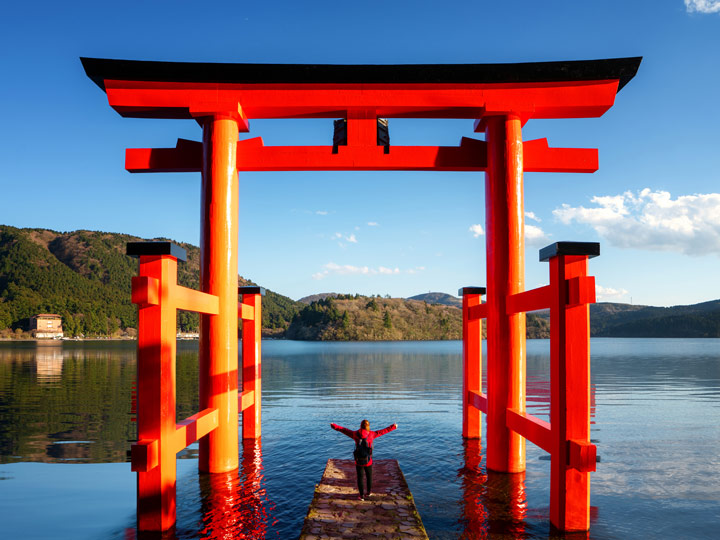
The scenic area of Fuji-Hakone-Izu National Park is perhaps the most popular place to visit between Tokyo and Kyoto. With jaw-dropping Mount Fuji views, pristine lakes, and lush forests, this stopover is a must for outdoor enthusiasts.
While the park isn’t directly on the Tokaido shinkansen line, you can easily transfer from Odawara Station to multiple destinations via the Hakonetozan line or the local bus routes.
There’s a lot to see and do Fuji-Hakone-Izu National Park, so you’ll want to carefully plan out your trip to make the most of your time. Here are a few highlights to visit along your route:
- Chisuji Falls – Ribbon-like streams of water flow down a mossy rock face
- Ōwakudani – An active volcanic crater with billowing steam and Mount Fuji views
- Hakone Ropeway – A sky-high cable car carries you across the valley and down to Lake Ashi
- Sengokuhara Susuki Grass Fields – Expansive fields of golden pampas grass best viewed in late autumn
- Hakone-en – Lakefront garden with wetland walking paths
- Hakone Shrine – 1,200-year-old Shinto shrine with a famous floating torii gate
- Old Tokaido Road Ancient Cedar Avenue – Stunning hiking path beneath towering cedar trees
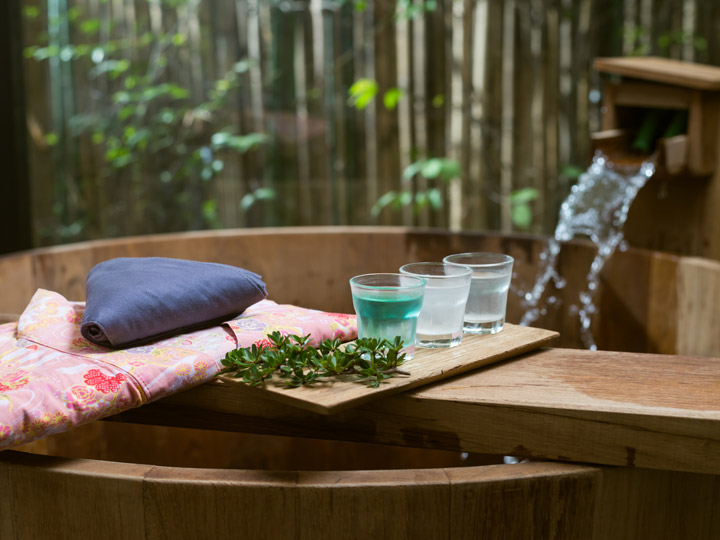
Outside of Japan, Atami is not a well-known tourist destination. Unlike Yokohama, this oceanfront city isn’t packed with a variety of things to see and do. Instead, most travelers come here for one thing: onsen .
Atami is regarded as one of Japan’s best onsen resort areas, with hundreds of hot spring baths (natural and man-made) where you can relax the day away. While some resorts require an overnight stay, others offer day passes or short sessions to day trippers.
Here are some of Atami’s top onsens:
- For the ultimate onsen experience, Watei Kazekomichi offers tranquil rooms in a lush setting with mountain views.
- Budget travelers will love Onsen Hostel Hinoemi ‘s great ocean views and short walking distance from the station.
- For day trippers, Hiratsuru and Hotel Micuras offer day access to their elegant baths and restaurants.
Note that many Atami onsen prohibit guests with tattoos. However, some will allow small tattoos to be covered by a bandage when using public baths, so be sure to add that to your travel checklist ! Places with private baths tend to be more lenient, but it varies by establishment.
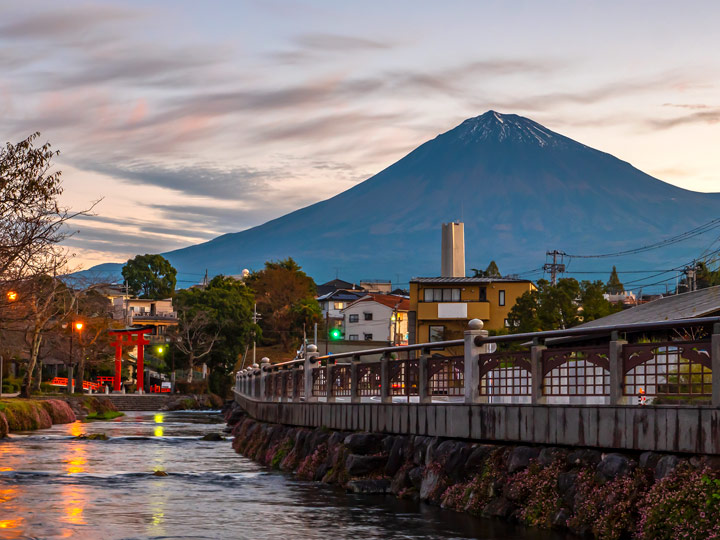
Catching a glimpse of Mt. Fuji on the shinkansen trip between Kyoto and Tokyo is a special treat. But if you want to get up close and personal with Japan’s famous mountain, plan to stop at Shin-Fuji Station.
If you’re pressed for time, you can simply hop off the train and enjoy spectacular views from the platform and the northern exit. Then, walk north along Fujimiodori (the main road) until you reach Chuo Park (中央公園 東地区 on Google Maps), where you’ll get gorgeous views of Fuji-san.
I only recommend this short stop if you bought a Japan Rail pass . Otherwise, it’s best to get your money’s worth and extend your stopover into Fujinomiya. You’ll need to walk about 20 minutes from Shin-Fuji Station to Fuji Station, and then take the Minobu line to Fujinomiya Station.
Fujinomiya is a charming town with a striking contrast of traditional and modern architecture. Nestled along a branch of the Urui River lies Fujisan Hongu Sengen-Taisha , a beautiful complex of historic shrines and gardens. And just a few minutes’ walk south, you’ll find the impressively modern Mt. Fuji World Heritage Centre , a museum dedicated to the cultural importance of Fuji-san.
If you have time to spare, take a short bus trip from Fujinomiya Station to Shiraito Falls . This horseshoe-shaped curtain waterfall is lovely any time of year, but is truly resplendent in autumn. It’s a fantastic place to enjoy Japan off the beaten path .
Note that only the Kodama trains on the Tokaido Shinkansen line stop at Shin-Fuji. However, they run every 30 minutes, so you won’t have to wait long when you’re ready to continue onward.
Save me for later!

Shizuoka City
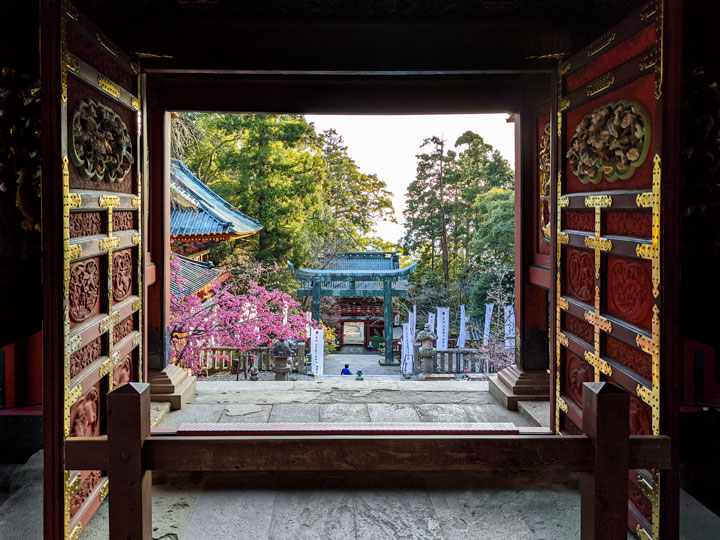
Colorful shrines, Mount Fuji views, green tea cafes… Shizuoka City is easily one of the best places to visit between Tokyo and Kyoto.
Shizuoka prefecture is a popular destination for nature lovers. But international travelers tend to overlook the region’s capital city. It’s an off path destination that’s paradoxically on the Golden Route, and an essential stop on my 10 day Japan itinerary .
Kick off your Shizuoka stopover at the Nihondaira , a park/observatory at the top of Mount Udo. It’s free to enter and offers 360 degree panoramic decks overlooking Shizuoka prefecture and the ocean. On a clear day, you can get incredible views of Mount Fuji rising above the city.
Thanks to Japan’s fantastic public transit system, you don’t need a car to reach Nihondaira. Simply catch the bus bound for Nihondaira Ropeway from Shizuoka Station. Buses run about every hour, and you can pay with ICOCA cards or change. You can check the timetables and other travel information here .
Once you’ve explored the Nihondaira, you can take a scenic cable car ropeway down to the next Shizuoka highlight: Kunozan Tosho-gu shrine .
If you want to impress people in Japan, tell them you visited Kunozan. Japanese people know about Kunozan Tosho-gu because it’s where Tokugawa Ieyasu, the renowned shogunate leader, is enshrined. But funnily enough, international travelers are more likely to visit Nikko Tosho-gu in northern Japan, which was built to honor Ieyasu.
Kunozan is the kind of magical place that draws travelers to Japan. Don’t be surprised if exploring the serene temple grounds becomes the highlight of your trip!
Round out your excursion at Miho no Matsubara . This tree-lined beach is considered one of Japan’s best scenic points, especially when Mount Fuji is visible in the distance on clear days. It’s a bit tricky to get here via public transit, so your best bet is to take a taxi (I either use the Japan Taxi app or ask my hotel to order one for me).
Once you’re back in the city center, head to a matcha cafe for some refreshments. Shizuoka produces over 40% of Japan’s green tea, and there’s no better place to sample it than CHA10 . This modern cafe serves tasty desserts and unique twists on green tea drinks, including a phenomenal matcha nitro.
For a more substantial meal in an Insta-worthy setting, check out Flowery Cafe Cachette . Most of their dishes have edible flowers, and their range of fizzy drinks and teas come in vibrant hues of pink, green, and purple.
Before you hop back on the train, take a short detour to Sunpu Castle . The grounds are free to enter and make for a lovely post-meal stroll.
Spending the night in Shizuoka
There’s so much to see in Shizuoka that I suggest spending the night. For an ultra-convenient and comfortable stay, book in at The Hotel Associa Shizuoka . You’ll be in the heart of the city with easy access to the train station, restaurants, and matcha cafes.
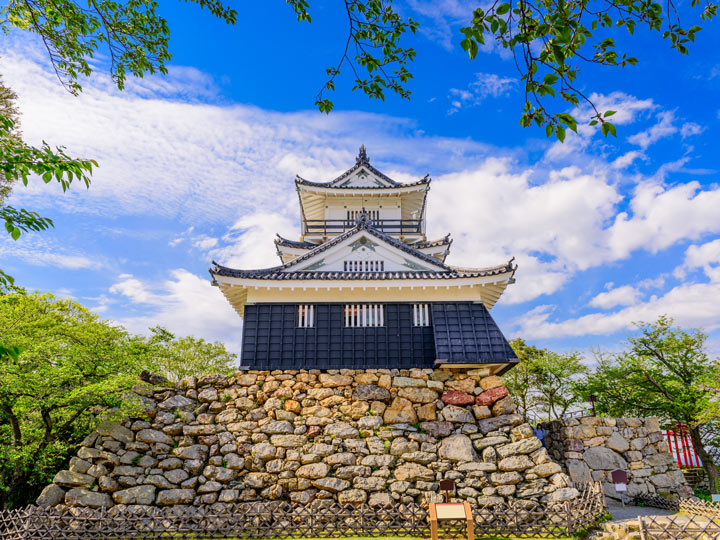
Hamamatsu is an ideal stopover for nature fans. Like Shizuoka City, Hamamatsu is more popular with Japanese tourists than international ones, though that’s begun to shift in recent years.
With rivers, mountains, lakes, and ocean beaches, there’s natural beauty aplenty here. Nakatajima Sand Dunes are particularly impressive and easy to reach by bus from the main station.
Hamanako Garden Park is a whimsical mix of Instagrammable buildings and flowers. And if you have an adventurous spirit, you can explore the waterfalls and stalactites of Ryugashido Cavern .
If you’re trying to stay close to the main station, you’re in luck! There are several great attractions within walking distance.
Hamamatsu Castle ’s black walls rise above the city and surrounding park. Music lovers shouldn’t miss the Hamamatsu City Museum of Musical Instruments , an interactive museum with hundreds of instruments from around the world. And Gosha Shrine ’s colorful buildings and Shishi dog statues are a must see.
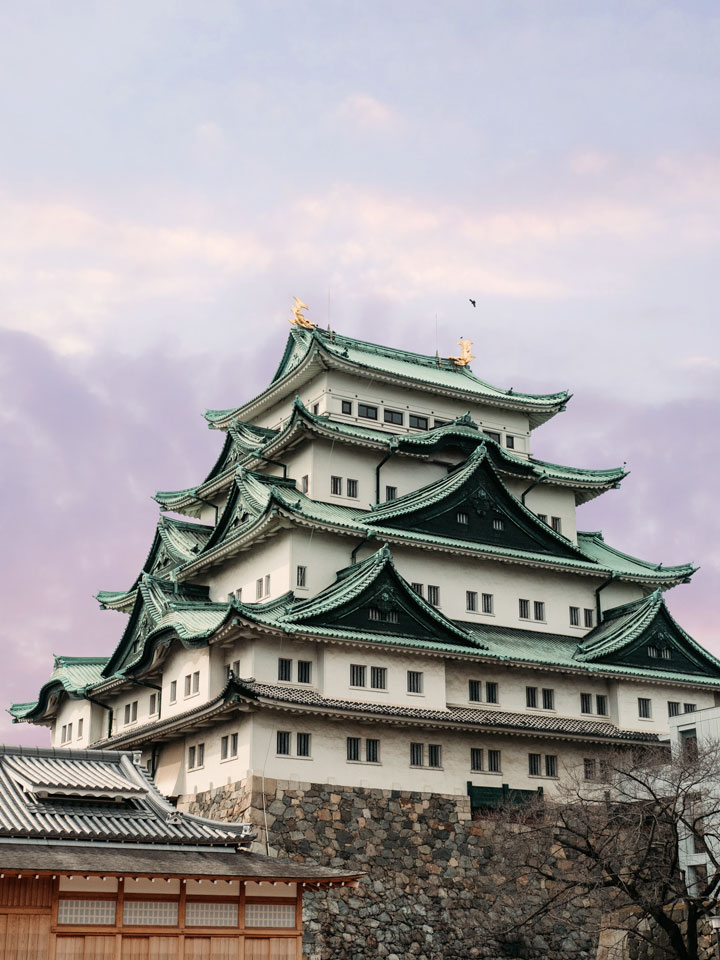
Nagoya Castle is one of the most recognizable places to see between Tokyo and Kyoto. So it’s not surprising that most JR pass holders make a quick stopover here. But it would be a mistake to not explore more of Japan’s fourth-largest city!
Located in the middle of the bustling city, Atsuta Jingu is a peaceful haven of nature. Cypress trees tower behind the main hall and along the walking paths that criss cross the area. And flowering trees bring pops of color during spring and summer.
Just north of Nagoya Castle lies Meijo Park . It’s a popular cherry blossom destination in the spring, and a great place to spot Shiba Inu’s being taken for a walk.
And of course, there’s Nagoya Castle . This Edo-period marvel was one of the largest in Japan until being mostly destroyed in 1945. Its buildings are still being restored today, with the main keep set to be finished by 2023. Surrounding the castle, you’ll find a mix of Japanese gardens, ponds, hanging wisteria, and even a plum blossom grove.
Check out Osu Shopping District for unique souvenirs and local foods like miso-glazed tonkatsu and eel. I highly recommend the nearby branch of Atsuta Houraiken for hitsumabushi , a Nagoya speciality of miso-glazed grilled eel served with condiments like hot tea and pickled vegetables.
Fans of Studio Ghibli will love the recently opened Ghibli Park . Located a short bus + tram ride east of Nagoya city center, this whimsical wonderland was built up around the old replica of Satsuki and Mei’s house from My Neighbor Totoro .
While it used to be a huge fuss for non-residents to gain admission, it’s now possible to buy Ghibli Park tickets internationally! All tickets require an advanced online reservation , so be sure to plan this excursion out well before your departure.
Spending the night in Nagoya
Nagoya is the perfect stopover point between Tokyo and Kyoto. If you plan to spend the night, book in at Lamplight Books Hotel . This modern and affordable hotel sits above a cozy bookshop, and is a short walking distance from Nagoya Station.
You can also visit Nagoya as a day trip from Kyoto if you’d prefer not to stop your journey mid-way.
Still planning your trip to Japan? Check out this 6 day Tokyo itinerary or my Osaka-Kyoto-Nara itinerary for inspiration!
I hope you’re inspired to savor your journey across Japan! For more travel tips and inspiration, subscribe to my newsletter below.
Leave a Comment Cancel reply
This site uses Akismet to reduce spam. Learn how your comment data is processed .
- Tokyo Cheapo (繁體中文)
Old Tokaidō Road: Hiking from Tokyo to Kyoto
Japan is a hiker’s paradise. There are endless trails across the island chain that range from lush forests to coastal views and mountain peaks . If you are looking for a hike with history, you might have come across mention of the Old Tokaidō Road. Here is a brief guide to walk in the footsteps of Edo-era samurai.
What is the Old Tokaidō Road?
The Old Tokaidō Road was the main walking trail between Edo (the name for Tokyo during the Edo era , 1603–1868) and Kyoto , the former capital of Japan. It was an important — and probably quite busy — road for samurai, officials and merchants during that time.
Along the road, there were posts, inns, temples and shrines at the service of weary travelers. Nowadays, some of the religious sites remain, but most of the posts and inns are gone. There are some castle ruins near Hakone and an old inn in Okitsu left that you can check out.
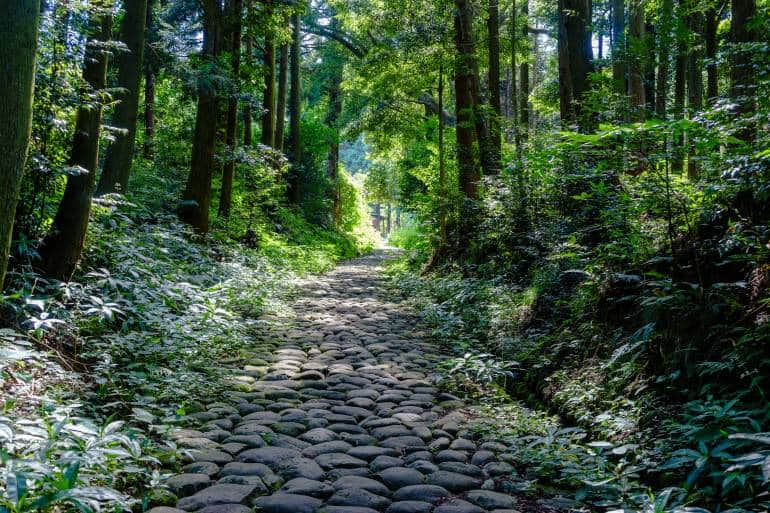
Can you still walk the Tokaidō Road?
Now, let’s be clear here: this is not the Japanese version of the Camino de Santiago in Europe that is completely walkable from beginning to end and fully caters to pilgrims. Sadly, most of the old trail has been swallowed up by National Route No. 1, also known as, you guessed it, the Tokaidō Highway — a motorway with no pedestrian walkway.
If you are ambitious, you can trace the whole trail from Tokyo to Kyoto, like this woman did . The whole route will take you around three weeks, but note that many bits of the road are rather mundane. Think slogging suburban landscapes and skirting around a highway.
However, other bits are well preserved offering proper, beautiful hiking trails. The most popular section is the one around Hakone in Kanagawa Prefecture.
How long does it take to walk the Tokaidō Road?
If you want to walk the whole trail, which is around 500 km from Nihonbashi in Tokyo to the outskirts of Kyoto, it will probably take you around 21 days.
This is the rough route of the Old Tokaidō Road:
The route starts in Nihonbashi , Tokyo and leads toward Kawasaki City on the outskirts of Tokyo. From there, you continue to Yokohama . The next stop is Hakone in the mountains. Then, walk back down to Mishima near Mt. Fuji . Follow the coastline passing Shizuoka. Make a stop in Nagoya. Finally, arrive in Kyoto .
If you want to walk just a portion of it, you could make a day trip to Hakone out of it. Alternatively, you can explore just the main sites along the Old Tokaido Road on foot while using the Tokaidō Shinkansen or local trains (which are much cheaper) to ferry you across the less scenic parts. As it is the Tokaido Line, you’ll stay faithful to your route. For the train and walking option, we would recommend devoting a week’s time.
Day trip itinerary: Hakone section

If you want to hike a small section, we definitely recommend the route through Hakone. There are signs and maps, though in Japanese, making it a proper hiking trail that takes around 2 hours to walk. The trail is beautiful, leading you through cedar alleys and featuring cobblestones from the original Tokaido Road.
Along the hike, you will come across the old Hakone checkpoint of the Tokaidō Road (Hakone Shrine), small temples and the ruins of Yamanaka Castle. Plus, views of Mt. Fuji on a clear day!

This section is an easy hike that can be done in a day. However, you may want to stay overnight in Hakone to give yourself lots of time to explore.
Before you start, best head to a tourist information center in Hakone and ask for a map and directions, which can be provided in English, Chinese or Korean.
The route starts in Hakone (Kanagawa Prefecture) and ends in Mishima (Shizuoka Prefecture), but some people opt to only explore the most scenic sections around Hakone.
If you want to go all the way to Mishima, you will have to cross the National Route No. 1 a few times, but there are signs in Japanese to guide you. In Mishima, the route ends at Nishikida-Ichiri-Zuka with milestone markers of the Old Tokaidō Road.
Old Tokaidō Road: One-week itinerary
If you want make it a longer adventure, consider this one-week itinerary of the Old Tokaidō Road.

Visit the Nihonbashi area in Tokyo which marks the starting point of the Old Tokaidō Road. It is a business district now though with not much to see, but have your morning coffee here. Then embark from Tokyo to Hakone (note: make sure you get an early start to your day). From Hakone, start your hike to Mishima, where you’ll stay overnight.
Take the train from Mishima to Shizuoka. From there, hike along the coast with stops in Kambara, an old post town and Okitsu. Consider staying at the old Oka-ya Inn in Okitsu . It is one of the last original inns of the Tokaido Road that is over 200 years old.
From Okitsu, take the train in Shizuoka and explore the city. You can hike along the Abe River which was crossed by travelers on the Tokaido Road back in the day. Take the local train to Hamamatsu and spend the night here.

Hamamatsu itself is a business city with not many sights to explore, but check out Hamana Lake, a massive body of water. You can hike along the lake and take boat tours. Continue along the Tokaido Road via local train to Nagoya and spend the night here. Nagoya’s bar and restaurant scene is definitely worth checking out at night!

Explore Nagoya for the day, the highlight being the well-preserved and impressive Nagoya Castle. In the late afternoon, take a local train to the city of Kusatsu, a small town on Lake Biwa in Shiga Prefecture. Kusatsu (not to be confused with Kusatsu onsen town in Gunma Prefecture) was another post on the Old Tokaido Road and the checkpoint can still be visited today.

From here, explore Lake Biwa, Japan’s biggest freshwater lake. Hikone Castle on the northwest side of the lake is a national treasure and not to be missed. Omihachiman boasts Hachiman-bori Canal, which offers boat tours down the picturesque stream that pass well-preserved historic warehouses. In the late afternoon, head to the other side of the lake to Takashima. There, you can enjoy the sunset behind the famous floating torii gates in the water, which are part of Shirahige Shrine.

You made it! The final stop of the Tokaido Road crossing is the Sanjo Ohashi Bridge in Kyoto . From here, explore one of Japan’s most beloved cities. There is a lot to see, so we recommend staying at least two nights.
Finally, a note on traveling this route via rental car on the National Road No. 1: While you would stay even closer to the original road with a rental car, road tolls in Japan are quite hefty, so it wouldn’t be the most economic scenario. The train network is super convenient and as the trains for this itinerary run on the Tokaido Line, you are staying pretty faithful to the old route, with some added modern conveniences.
- Castle Ruins
Get the best Japan Cheapo hacks direct to your inbox

June 2024: Top Events Around Japan
Fancy horses, dance festivals, fun with yukata, mud sports — and more.

Best Places To Stay in Nara
Because this beautiful city deserves to be more than just a day-trip destination.

15 Things To Do in Osaka: Explore "Japan's Kitchen"
Get ready for colorful nights, culinary delights — and much more.

May 2024: Top Events Around Japan
Giant battling kites, a thousand-samurai march, flower festivals and more!

Complete Guide to the Hokkaidō Shinkansen
Where to go and what to do along Japan's northernmost bullet-train route.

10 Adrenaline-Pumping Okinawa Adventures
The options are plentiful, the prices low. Choose from jungle treks, wild camping, zip-lining and more.

A Matcha Lover's Guide to Kyoto
Love tea? Then you'll love Kyoto.

Updated: 2024 Japan Cherry Blossom Forecast
The blooms are fashionably late. Here's when to see sakura in all the major cities.

April 2024: Top Events Around Japan
Look forward to flowers and festivals galore!

8 Perfect Places To See Cherry Blossoms in Osaka
Castle grounds, sprawling parks — and somewhere extra special.

Cherry Blossoms in Kyoto: 14 Best Sakura Spots
From temples to riversides, geisha districts — and more.

9 Things To Do in Fukui
Explore the shiny new stop on the Hokuriku Shinkansen — an easy trip from Tokyo.

Close without accepting
- Tokyo Cheapo (繁體中文)
Tokyo to Kyoto: The Fastest and Cheapest Ways to Travel
Kyoto is such a popular destination from Tokyo, and there are many ways to make the trip. The bullet train (aka the Shinkansen) — our favorite way to travel — can get you there in under 2.5 hours; other budget options include cheap flights and highway buses.
How to get from Tokyo to Kyoto
Kyoto is about 370 kilometers (225 miles) west of Tokyo. It’s part of the Kansai region, and thus actually much closer to Osaka : the two cities are about 30 minutes apart on the train. Coming from Tokyo, you’ll reach Kyoto before Osaka.
Top choice: Shinkansen
The fastest, easiest, and most convenient option is the Shinkansen, especially if you have a Japan Rail Pass . The cheapest option is usually a highway bus, followed by flights — but these are both a bit time-consuming.

Comparing Tokyo to Kyoto travel options
Here’s a quick overview of all the different types of transport.
Taking the Shinkansen from Tokyo to Kyoto
From ¥ 13,320 2 hours and 15 minutes (fastest service) Buy a one-way ticket on Klook or Rakuten Travel Experiences , or a JR Pass in advance
The Tōkaidō Shinkansen connnects Tokyo and Kyoto (and terminates one stop further, at Shin-Osaka Station). It’s a direct route, so you won’t usually need to transfer. There are three services on this line: Nozomi, Hikari, and Kodama; the travel time and cost varies by service.
Tōkaidō Shinkansen services to Kyoto
Nozomi is the fastest service on the Tōkaidō Shinkansen, and for this reason it costs a little bit extra. Note that the JR Pass covers travel on all services, including Nozomi.
Note: If you’re traveling during off-peak season, you can knock ¥ 200 off the reserved seat price. During peak season it’s an extra ¥ 200 (and an extra ¥ 400 during super-peak season). For more information on seasonal price fluctuations, see our breakdown of how Shinkansen fares are calculated .
Hikari and Kodama services are priced the same, even though Kodama services take signficantly longer — taking between 3.5 hours and 4 hours to make the trip between Tokyo and Kyoto!
Kodama services also stop at more stations, like Odawara, which is convenient if you want to work in a visit to Hakone on the way from Tokyo to Kyoto.

Departing Tokyo for Kyoto
You can board any Tōkaidō Shinkansen service for Kyoto Station at Tokyo Station , Shinagawa Station, or Shin-Yokohama Station. Ticket prices are the same whether you depart from Tokyo Station or Shinagawa Station. From Shin-Yokohama, the fare is cheaper by ¥ 670 .
After Shin-Yokohama, Nozomi services make one additional stop at Nagoya before Kyoto; meanwhile, Hikari and Kodama services make more stops along the way.
Arriving at Kyoto Station
Unlike some destinations, where the Shinkansen station is outside the city center, Kyoto Station is right in central Kyoto. You can transfer easily to local trains and buses, the city subway, or catch a taxi.

How often does the Shinkansen run from Tokyo to Kyoto?
The Tōkaidō Shinkansen is the most popular bullet train route in the country, with trains departing from Tokyo for Kyoto approximately every 10 minutes. There are PDF timetables here , or you can use navigation apps to plan your journey.
Seat reservations on the Shinkansen to Kyoto
The frequency of trains doesn’t mean you should board without a seat reservation. Opting for a non-reserved seat ( jiyūseki ) will save you a few hundred yen (see pricing above) — but could see you standing awkwardly the whole way to Kyoto.
Our advice (especially if traveling during rush hour and peak periods) is, if possible, to use those extra coins to get a reserved seat ( shiteiseki ). You can arrange this easily at JR ticket offices or at specially marked ticket machines.
You can even make seat reservations when activating your JR Pass, if you have one (reservations are free with the pass).
If you’re committed to non-reserved seats, just get to the station well before your planned departure time — so you can line up in the designated places on the platform to snag a seat. It’s also better to board the train at Tokyo Station, where the route begins, rather than get on one stop later at Shinagawa Station.

Buying Tokyo to Kyoto Shinkansen tickets
If you can’t get a JR Pass , or you’re only interested in traveling one way by Shinkansen to Kyoto, Klook offers a Shinkansen ticket service that can deliver your ticket to your accommodation. Prices are as charged by JR, but Klook adds a ¥ 1,200 fulfillment fee on top.
Another option is the discounted Shinkansen and Kyoto 1-day pass combo ticket, available on JTB . You’ll get a few hundred yen off the regular price.
You can also buy Shinkansen tickets at the station. Read our complete guide to buying Shinkansen tickets .
Luggage rules on the Tōkaidō Shinkansen
If you have a lot of luggage, or even one huge bag, consider sending it on ahead with a luggage delivery service. Shinkansen luggage rules dictate that luggage with combined dimensions of over 160cm but under 250cm will require special reservations (included in your JR Pass). Bags over 250cm won’t be allowed onboard the bullet train at all!
What rail passes cover the Shinkansen from Tokyo to Kyoto?
The only rail pass that covers travel on the Tōkaidō Shinkansen is the country-wide Japan Rail Pass . But from October 2023, using an All Japan Rail Pass for this journey only makes sense if you are visiting more places around the country as well.
There is, however, one regional rail pass that you can use to travel between Tokyo and Kyoto: the Hokuriku Arch Pass . The catch? You can’t use the Tōkaidō Shinkansen; instead, you use a combination of other Shinkansen lines and JR Limited Express lines to travel along an arching route from Tokyo to Kyoto via Nagano and Kanazawa .
Note: The JR Pass and the Hokuriku Arch Pass are only available to short-term visitors to Japan.
Discounts for Shinkansen tickets to Kyoto
Puratto Kodama Economy Plan allows travel on the slow Kodama service from Tokyo to Kyoto for [price amount=10600]–[price amount=12000] one way, depending on the season. You have to buy Puratto tickets at least 1 day in advance, and numbers are limited. Purchase them from JR Tokai Tours or from any JTB Travel counter in Tokyo.-->
Low-cost flights from Tokyo to Kyoto
From ¥ 4,000 (one-way) + travel cost to/from the airport 90 minutes (flight time) + travel time to/from the airport Narita Airport or Haneda Airport to Kansai International Airport (KIX)
The nearest, most convenient airport to Kyoto is Kansai International Airport, which is not really that close to Kyoto. While the flight time is minimal — quicker than the Shinkansen — it’s the time spent getting to and from the airports that adds up.
You’ll need more than an hour on each end, just for travel to and from the city center. Or a minimum 30 minutes on the Tokyo side if you use Haneda Airport instead of Narita. That extra travel costs extra money, too.
Prices for flights start around ¥ 4,000 to ¥ 6,000 one way, but can go for twice as much. There are promo fares and sales every so often, so be on the lookout.

Departing Tokyo
Currently, StarFlyer is the only one of Japan’s budget airlines flying the Haneda–KIX route. All other LCCs depart from Narita Airport, which means you need to factor in the time and cost of traveling between Tokyo and Narita Airport . You need to budget around 90 minutes for this journey, and a minimum of ¥ 1,000 .
It’s generally quicker and cheaper to travel between central Tokyo and Haneda . You can do it by public transport from most center city districts in about 30 minutes. However, flights from Haneda are often more expensive.
Arriving at Kansai International Airport
Once you land at Kansai Airport, you’ll have to board a train or bus to Kyoto .
The JR Haruka Ltd. Express service connects Kansai Airport to Kyoto in 75 minutes. The ride costs about ¥ 3,630 one-way in high season. However, discounted tickets can be purchased online (foreign passport holders only) for as little as ¥ 1,800 .
ICOCA & Haruka package deal
For short-term visitors, we recommend getting an ICOCA & Haruka package at the airport station ticket office. This is a good deal at ¥ 3,800 one-way (and ¥ 5,600 for a round trip).
In addition to transport from the airport, you get an IC travel card called ICOCA that comes with an initial balance of ¥ 1,500 . You can use this card to pay for rail and bus travel in Kyoto and around Japan.
Note 1: Residents of Japan cannot buy this package. Note 2: The route from Kansai Airport to Kyoto is also covered by the JR Pass and most JR West regional rail passes.
What about Osaka’s Itami Airport?
Low-cost carriers generally don’t fly into Osaka Itami Airport. You can book flights from Tokyo’s Haneda Airport to Osaka Itami Airport on legacy carriers like JAL and ANA. However, you are still looking at a 1-hour bus ride into Kyoto (or multiple train transfers).
Highway buses to Kyoto from Tokyo
From ¥ 3,100 one-way 7 hours or more
Several different companies operate highway buses along the route between Tokyo and Kyoto (and nearby Osaka). A ride starts from as little as ¥ 3,100 and can go up to around ¥ 12,000 , depending on comfort and season.
The journey takes about 7 to 9 hours. Buses that depart from Tokyo during the day usually take longer due to traffic. Late-night buses, which are the preferred option, depart Tokyo between 9 p.m. and midnight, and can get you to Kyoto Station as early as 5:15 a.m., giving you a full day to explore.

Play around on Headout , as well as bus companies like Willer Express and Kosoku Bus to see what your cheapest options are.
Note: Many buses from Tokyo end their journey in Osaka, which is not far from Kyoto. The two cities are just a 30-minute train ride apart. So, if you find a good price on a bus ticket that goes to Osaka but not Kyoto, it’s still a viable option. Read up on other ways to get from Tokyo to Osaka.
Regular trains: The slow travel option
Approximately ¥ 8,360 one-way 8 hours or more + transfer time Tokyo, Shimbashi, Shinagawa, Kawasaki or Yokohama Station to Kyoto Station

The approximate cost of a one-way trip from Tokyo to Kyoto on regular, rather than bullet, trains, is ¥ 8,360 . Those are not huge savings over the Shinkansen, considering the journey would take all day!
The Tōkaidō Main Line follows roughly the same path as the Tōkaidō Shinkansen, but makes over 100 stops. No single train travels the whole route, so you’d have to transfer at least four times.
The Seishun 18 Pass
There is, however, a hack that allows significant savings, which makes this journey more attractive. The Seishun 18 Pass is a seasonal rail package consisting of five tickets (for 5 consecutive or non-consecutive days of travel) for ¥ 12,050 . Anytime during the validity period, solo travelers can use up all 5 days, or group travelers can split them among themselves. In effect, 1 day of travel costs just ¥ 2,410 per person.
The catch? The pass can only be used on local and rapid JR trains, which makes for long journeys. Plus, it’s only valid for a few weeks, three times a year. Read more about the Seishun 18 Pass and how you can take advantage of it.
Driving from Tokyo to Kyoto
From ¥ 15,000 one way 5 hours and 30 minutes or more
Japan has a well developed, but expensive highway network. On top of fuel (likely ¥ 8,000 to ¥ 12,000 depending on vehicle size), rental car charges, and sky-high parking prices on arrival, the highway toll charges alone from Tokyo (Shinjuku) to Kyoto (Sanjo) will set you back between ¥ 10,000 and ¥ 15,000 . That works out to a lot more than any of the other options here.
With rest stops, the journey can easily take 6 and a half to 7 hours. If you feel like you need to drive, we recommend renting after you arrive at your destination, rather than wasting time and money going back and forth from Tokyo to Kyoto by car.
For more on traveling by car, see our guide to renting a car in Japan .
Video guide to travel between Tokyo and Kyoto
The reverse route: Traveling from Kyoto to Tokyo
If you are looking for the best ways to get from Kyoto to Tokyo, rather than the other way round, your transport options are almost exactly the same — with a few different special offers for tourists. We have a dedicated guide to the reverse route — read it here .
Tokyo to Kyoto travel FAQs

Can I do a day trip from Tokyo to Kyoto?
While we recommend spending a few days in Kyoto, the simple answer is yes. As long as you plan things very carefully, you can manage a lot in a day trip to Kyoto from Tokyo.
A guided tour of Kyoto can help you fit in a lot of the best places without having to worry about logistics.
The Shinkansen is the best option for a day trip, as it starts running around 6 a.m. and the last train departs Kyoto for Tokyo at around 9:30 p.m. So you can get a full day of sightseeing, in if you’re prepared to be up with the larks and go to bed late. You can also get a full day in Kyoto by using a night bus there and a night bus back, but this can be tiring.
How far is it from Tokyo to Kyoto?
Kyoto is about 370km (225 miles) west of Tokyo as the crow flies. By rail or road, the journey is more like 460km (285 miles).
How do you get from Tokyo to Kyoto?
The fastest and easiest way is taking the bullet train (Shinkansen). Alternative ways of getting between the two cities include highway buses and airplanes, including low-cost flights.
How long does it take to get from Tokyo to Kyoto?
It depends whether you take the bullet train, bus, or plane (or local trains). If you choose to travel by plane, you are looking at about 90 minutes in the air, and a couple of hours of transfer time either side (you need to get to Narita or Haneda Airport in Tokyo and then from Kansai International Airport in Osaka to Kyoto). This makes the Shinkansen, at 2 hrs 15 min to 3 hrs 40 min, the fastest option for getting from central Tokyo to central Kyoto.
How long does it take to get from Tokyo to Kyoto by Shinkansen?
The fastest bullet train service, the Nozomi, will get you there in about 2 hours and 15 minutes. The second-fastest option, the Hikari, takes about 20 minutes longer. And the slowest option, the Kodama, takes about 3 hours and 40 minutes from Tokyo to Kyoto.
Unlike some Shinkansen stations, which are located in satellite hubs (and often have “Shin” or “New” amended to their names), both Tokyo Station and Kyoto Station are centrally located.
How much is the Shinkansen from Tokyo to Kyoto?
Without discounts, a one-way ticket with non-reserved seating costs ¥ 13,320 . For a reserved seat, which we recommend, the price is a little more: ¥ 13,650 – ¥ 14,570 , depending on the service and season. The faster Nozomi service is more expensive than Hikari and Kodama services (but only if you’re reserving a seat).
Should I buy a JR Pass to get from Tokyo to Kyoto?
If Tokyo to Kyoto is your only trip, then a Japan Rail Pass (JR Pass) will not be worth it. You’ll want to buy a point-to-point Shinkansen ticket . However, if you are planning to travel extensively, e.g. Tokyo to Kyoto, and then on to Hiroshima and Fukuoka, a JR Pass can save you money. Read more about the JR Pass .
Can you see Mt. Fuj from the Shinkansen to Kyoto?
On a clear day, yes. For the best view of Mt. Fuji , snag yourself a window seat on the right side of the train.
When is the best time to book travel between Tokyo and Kyoto?
The usual peak travel season cautions apply. Travel in Japan is always more hectic, crowded, and expensive during peak periods, which include: year-end/New Year’s, cherry blossom season (late March to early April), Golden Week, and summer break (late July through August). This is especially true in Kyoto, which is a very, very popular domestic tourist destination.
Shinkansen tickets fluctuate only slightly — a couple of hundred yen — but flights and buses, with dynamic pricing, can cost as much as twice the price of an off-peak ticket.
Coming from overseas? Kyoto’s nearest major airport is Kansai International Airport (KIX). From there, you can pick-up transport from the airport to Kyoto .
While we do our best to ensure it is correct, pricing and other information is subject to change. This post was originally written by Tiffany . First published in February 2015. Last updated in October 2023.
- Bullet train
- Highway bus
- Low-cost carriers
- Rail Passes
- Sustainability
- Weekend-getaway
Get our Tokyo Cheapo Hacks direct to your inbox

Renting a Pocket Wifi Router in Japan: The Best Options

Luggage Storage In Tokyo

Top Japanese Phrases You Need Before Traveling to Japan

Tokyo Disneyland: Everything to Know Before Visiting

Hidden Gems: 4 Unique Tokyo Bars You MUST Try!

Hidden Gems: Tokyo's BEST Underrated Shrines and Gardens

Best Budget Sushi Restaurants in Tokyo

11 Things To Do Around Kawaguchiko Station
Forget about the controversial Lawson — here's what you should be looking at.

Understanding the Shinkansen Luggage Rules
All your questions about size and seats, answered.

The Japan Bus Pass: Does Road Beat Rail?
It's cheaper than the JR Pass, and not just available to tourists.

A Case for Luggage Delivery in Japan
For hands-free travel around the country.

10 Tokyo Flea Markets for Bargain Hunting
You'll want to bookmark this one.

The Tokyo Wide Pass: Everything You Need To Know
This discount pass is available to foreign residents and tourists alike. See what you can do with it.

New Video! When is the Worst Time to Visit Japan?
Winter, spring, summer, or fall? It can be hard to know the best time to book your Japan trip for.

Taste of Hakone: Easy Day-Trip Itinerary
From hot springs and museums to shrines and pirate ships, here's our DIY guide.

Complete Guide to the Tōkaidō Shinkansen
Everything you need to know about Japan's most popular bullet train.

English-Speaking Hospitals in Tokyo — And How To Visit Them
Absolutely everything you need to know about seeing a doctor in Japan.

Yozakura: 8 Best Nighttime Cherry Blossom Illuminations in Tokyo
Light-ups have been extended, since the blossoms were so late this year.

New Video: Tokyo's Best Airport — Flying into Narita vs. Haneda
Which one should you use when flying to Tokyo?

Close without accepting
How To Get From Tokyo To Kyoto [2024]
![road trip tokyo to kyoto How To Get From Tokyo To Kyoto [2024]](https://i0.wp.com/thetravellingtedaldi.com/wp-content/uploads/2024/05/DSC06468.jpg?fit=1440%2C960&ssl=1)
By Gemma Tedaldi | Published: 27th May 2024 | Updated: 30th May 2024

When visiting Japan, especially as a first-time visitor, Tokyo and Kyoto are often top of people’s lists of places to get to. So how easy is it to get from Tokyo to Kyoto, and what is the best way to get between Tokyo and Kyoto?
Table of Contents
Tokyo to Kyoto by Car
Tokyo to kyoto by bus, tokyo to kyoto by local train.
- How long does it take to get from Tokyo to Kyoto by Shinkansen?
- How much is the Shinkansen from Tokyo to Kyoto?
- What rail passes cover the Shinkansen from Tokyo to Kyoto?
Tokyo to Kyoto by Flight
What is the best way to travel from tokyo to kyoto, can you do a day trip from tokyo to kyoto, how long is the regular train from tokyo to kyoto, how far is it from tokyo to kyoto, should i buy a jr pass to get from tokyo to kyoto, can you see mount fuji from the shinkansen between tokyo and kyoto, planning your trip use our favourite travel resources below:.
Accommodation: We recommend Booking.com
Rental Car: We recommend Rentalcars.com
Flights: We recommend Kiwi.com
Tours: We recommend Get Your Guide

It takes roughly 5 – 6 hours without breaks, to drive between Tokyo and Kyoto. Assuming you take the quickest route via the Tomei and Meishin Expressways, you will also have to pay around 10,000 yen one way on top of any fuel costs.
A one-way trip from Tokyo to Kyoto takes anywhere from 7 hours, with one-way fares from 3,500 yen for a discount bus up to 10,000 yen for a premium bus. You can get a Japan Bus Pass which reduces the costs and reserve a seat online at Japan Bus Online .
Going from Tokyo to Kyoto by local train is not for the faint-hearted! It typically takes 9 hours and involves at least 4 train transfers, but it is cheaper than taking the Shinkansen at approximately 8,400 yen.

Tokyo to Kyoto by Shinkansen
Taking the Shinkansen is one of the easiest ways to get from Tokyo to Kyoto, with multiple trains every hour that run along the JR Tokaido Shinkansen, including the Nozomi, Hikari and Kodama. The first Shinkansen that runs from Tokyo to Kyoto is 12:30 and the last departure is at 21:00.
🚅 How long does it take to get from Tokyo to Kyoto by Shinkansen? 🚅
It takes on average 2.5 hours to get between Tokyo and Kyoto, but the Kodama trains take around 4 hours.
🚅 How much is the Shinkansen from Tokyo to Kyoto? 🚅
A regular one-way ticket from Tokyo to Kyoto costs around 13,300 yen for a non-reserved seat and 14,000 yen for a reserved seat.
🚅 What rail passes cover the Shinkansen from Tokyo to Kyoto? 🚅
The JR Pass is valid on the Hikari and Kodama trains but you will have to pay an extra fee on Nozomi trains. You can also use the Tokyo-Osaka Hokuriku Arch Rail Pass.
Planning your own trip to Japan? Be sure to download Wise by far the best currency conversion app around. We use it daily living on the border or two countries and it is a game changer when travelling!
You can’t fly directly between Tokyo and Kyoto, but you can fly from Tokyo Haneda or Narita to Osaka’s Itami Airport in an hour. From Itami Airport it takes another hour to get to central Kyoto. This costs anywhere between 9,000 to 23,000 yen.

How To Get From Tokyo To Kyoto FAQs
The best way to travel between Tokyo and Kyoto is via Shinkansen for ease of travel, (no changeovers), and the speed on which you can get there.
Honestly no. You can in theory travel back and forth between Tokyo and Kyoto in a day, but it would be a long day, (2.5 hours each way!), and you wouldn’t get to spend enough time exploring Kyoto.
The regular train between Tokyo and Kyoto takes roughly 9 hours.
Tokyo is located approximately 466 km / 290 miles north east of Kyoto.
We wouldn’t suggest buying a JR Pass to get from Tokyo to Kyoto, especially with the new price increases that came into effect in 2024. We found it cheaper to travel around Japan purchasing tickets as we went – more detail on that in our getting around Japan post.
If the weather is good with minimal haze, then yes you can in theory see Mount Fuji from the Shinkansen between Tokyo and Kyoto. We didn’t see Fuji whilst on the Shinkansen, but we did travel along that route in the evening during the winter so it was already dark!
Conclusion: How To Get From Tokyo To Kyoto
So there are multiple ways to get from Tokyo to Kyoto, with some options taking up to 9 hours and others a little as 2.5 hours. But with varying prices, and some more of a hassle than others, we think that taking the Shinkansen is by far the best way to get between Tokyo and Kyoto.
All Our Japan Content
Here are a few other articles you may find useful for planning your trip:
📍 Is There Uber In Japan?
📍 How To Get From Tokyo To H iroshima
📍 How To Get From Tokyo To Hakone
📍 How To Get From Kyoto To Osaka
📍 How To Get From Kyoto To Nara

Gemma is the owner and author of The Travelling Tedaldi, a travel blog helping travellers to discover the best road trips and travel itineraries throughout the UK and Europe. When she isn’t writing about her favourite travel destinations, she can often be found out exploring local hikes or planning future trips.
How To Get From Tokyo to Kyoto
Traveling from Tokyo to Kyoto opens up a world of possibilities for exploration. Tok y o lies on the southeastern side of Honshu, Japan’s main island. It’s known for blending traditional culture and futuristic innovation as well as its iconic landmarks and vibrant culinary scene. Kyoto boasts exquisite temples, shrines, and preserved historical architecture, offering a captivating glimpse into the country’s rich cultural heritage. The distance from Tokyo to Kyoto is approximately 450 kilometers (280 miles).
Numerous transportation options are available, including guided tours, rental cars, buses, trains, and private transfers. Tours streamline the Tokyo to Kyoto travel experience while providing a chance to unlock the country’s rich cultural treasures. However, other modes of transport offer the flexibility of making scenic stops along the way. Keep reading to discover all the options for getting from Tokyo to Kyoto.
Best Way to Get from Tokyo to Kyoto: Join a Tour

Guided tours from Tokyo to Kyoto offer numerous advantages that enhance your overall travel experience. Tourist Italy’s tours enable you to explore the hidden gems and off-the-beaten-path attractions along the route. This way, you’ll discover more of Japan’s captivating culture and breathtaking landscapes between the iconic cities on an immersive adventure. Many of our packages which include train transfers between cities, stand out for their efficiency and convenience. You’ll be able to savor every moment exploring the best parts of Japan, enjoying the highlights of each city while also discovering lesser-known hidden gems.
We also offer a range of Japan package tours that do not include transportation but will help you maximize your time at each destination. From a unique 7-day Flavors of Japan culinary tour to our packages like the 8-Day Tokyo, Kyoto, Nara & Osaka Tour or the Tokyo, Osaka & Kyoto 10-Day Tour , you have plenty of options. With all these, your accommodation and activities are pre-organized, allowing you to easily explore more locations throughout Japan.
See all Japan Package Tours
Other Ways to Get From Tokyo to Kyoto

Getting from Tokyo to Kyoto by bus is a convenient travel option. The trip duration averages seven to nine hours. Ticket prices vary based on the company, class, and amenities but generally range from ¥3,600 to ¥16,000. Buses depart from Tokyo’s travel hubs like Tokyo Station or Shinjuku Station and arrive at various locations in Kyoto, including Kyoto Station and major hotels. Companies serving this route include Willer Express, JR Bus Kanto, and Kintetsu Bus, offering a range of daily departures to accommodate your schedule. Or, you can pre-book a shuttle bus for a hassle-free transfer between the two cities.
The Tokyo to Kyoto bullet train offers a seamless and efficient journey through the picturesque landscapes of Japan. Departing from major stations like Tokyo Station or Shinagawa Station, the high-speed Shinkansen Tokyo to Kyoto bullet trains provide a swift connection in under two-and-a-half hours. The Tokyo to Kyoto bullet train cost ranges from approximately ¥11,000 to ¥16,000. The train from Tokyo to Kyoto runs frequently throughout the day, with multiple departures each hour. This bullet train from Tokyo to Kyoto showcases Japan’s well-developed railway network, renowned for its punctuality and comfort. It’s a top choice for locals and tourists alike.
Driving from Tokyo to Kyoto is a scenic road trip across Japan’s picturesque landscapes, spanning approximately 450 kilometers (280 miles). The trip duration varies depending on traffic and stops, averaging around six to eight hours. There are tolls along the route, which adds to the overall cost of the journey. An International Driving Permit (IDP) and a valid driver’s license from your home country are required for foreign tourists driving in Japan. Additionally note that in Japan, they drive on the left side of the road.
Private Transfers
Booking a private transfer between Tokyo and Kyoto offers a luxurious and convenient travel option. Private transfer services provide the comfort of a dedicated vehicle and a professional driver, ensuring a seamless journey tailored to your schedule and preferences. While it typically costs more than other modes of transportation, the convenience, personalized experience, and simplicity provide a stress-free and efficient travel experience. Private tours in Japan are worth the higher expense if you value comfort, security, and flexibility to explore en route.
Rice and Shrine – It’s Time to Explore Kyoto!
In the captivating journey from Tokyo to Kyoto, each travel option has different advantages. Guided tours are an outstanding choice. They seamlessly weave together the allure of both cities while expertly managing all logistical details. This immersive approach ensures a stress-free adventure and allows travelers to delve into the heart of Japan’s culture. Additionally, other transportation methods like buses, trains, and rental cars offer their own unique appeals. For independent travelers, Kyoto tours like our Historical Cycling Tour and Best of Kyoto Day Tour provide an enriching and unforgettable exploration of the city’s countless treasures. If you’re looking for more ideas for your time in Kyoto , we have plenty of inspiration. From Kyoto’s best contemporary art galleries to the city’s most Instagrammable places , like the Fushimi Inari Taisha Shrine , we’ve got all your travel needs covered.
Subscribe for insider tips to Japan Enter your email address to stay in-the-know of what's new in Japan. We promise to only send you guides to the best experiences. Email Keep Me Updated
Recommended

Related Articles

2 Days in Kyoto

5 Things You Can Only Do in Japan

Best Bars in Tokyo

6 Important Japanese Customs

Yanaka: A Journey Through Time in Tokyo’s Hidden Gem

A Guide to Prepaid IC Cards in Japan

The Japan Golden Route: Everything To Know

Luggage Storage in Kyoto

How to Get From Kyoto to Nara

How To Get From Tokyo to Kamakura
Inside Kyoto
A Kyoto Travel Guide
- 10 Day Japan Itinerary: Tokyo, Kyoto and Takayama
If you’ve got 10 days to spend and will be in Japan during the warmer months, then consider adding Takayama to the classic Tokyo-Kyoto itinerary. On the doorstep of the Japan Alps, Takayama is conveniently located between Tokyo and Kyoto.


Itinerary Summary
- Duration: Around 10 days.
- Perfect for: First time visitors to Japan who like mountains and who will be in Japan between late March and late October (when the snow has melted in Takayama and the weather is warm).
- Places visited: Tokyo, Takayama and Kyoto.
- Arrival City/Airport: Most people fly into Tokyo’s Narita or Haneda airports to do this itinerary. You can also fly via Kansai International Airport (KIX), which is the nearest international airport to Kyoto/Osaka.
- Best Season: Any time of year.
- Japan Rail Pass: A one-week Japan Rail Pass will save you a bit of money. For more details, see our Japan Rail Pass: Is It Worth It? page. Be sure to activate your pass on the day you leave Tokyo (not before).
Hire A Travel Expert To Plan Your Japan Itinerary

The Full Itinerary
Day 1: Arrive in Tokyo You’ll probably arrive at Narita International Airport (NRT), but some flights also go into the more convenient Haneda International Airport (HND). See our Tokyo Airport Transport page for details on getting into Tokyo from the airports.
Day 2: Tokyo: Modern Tokyo On your first full day in Tokyo, you’ll explore the modern west side of the city. See our full Tokyo Two-Day Itinerary for details.
Check Hotel Availability
Destination, check-in date, check-out date.

Day 3: Tokyo: Traditional Tokyo On your second full day in Tokyo, you’ll explore the traditional east side of the city. See our full Tokyo Two-Day Itinerary for details.
Day 4: Travel to Takayama Take the shinkansen from Tokyo to Nagoya and change to a Hida Wide View express train to Takayama. The total journey takes 4 hours, 20 minutes, and costs Y13,930. The Japan Rail Pass covers this leg. For details, see our Getting to Takayama page.

Day 5: Explore Takayama On this day, you’ll explore the Sanmachi Suji district, the heritage houses, the Takayama Festival Floats Exhibition Hall and Sakaurayama-Hachimangu Shrine. For details, see our Must-Do Takayama One-Day Itinerary . If you have more time to spare in this area, consider staying another day and taking a day trip or overnight trip to the mountain sanctuary of Kamikochi. For details, see the Attractions Around Takayama section of our Things to Do in Takayama page.
Day 6: Travel to Kyoto Take a Hida Wide View express back to Nagoya and take the shinkansen to Kyoto. The whole journey takes 4 hours, 20 minutes, and costs Y13,930. The Japan Rail Pass covers this leg. For details, see our Getting to Takayama page.
Day 7: Kyoto: Southern Higashiyama On your first full day in Kyoto, you’ll explore the temple-packed Southern Higashiyama area. See our full Kyoto Three-Day Itinerary for details.

Day 8: Kyoto: Arashiyama On your second full day in Kyoto, travel west to the Arashiyama district, which is home to the famous Arashiyama Bamboo Grove. See our full Kyoto Three-Day Itinerary for details.
Day 9: Return to Tokyo Take the shinkansen back to Tokyo. For details, see our How to Travel from Tokyo to Kyoto page. You’ll probably have some time in the afternoon to do some last-minute shopping or sightseeing. Note, if your flight out of Tokyo leaves after 3pm, you might be able to spend this night in Kyoto (see the note below).
Day 10: Leave Japan Return to Narita or Haneda airport and fly home. See our Tokyo Airport Transport page for transport details.
Important Note on Leaving Kyoto and Flying Out of Tokyo the Same Day
If your departure from Tokyo is after 3pm, you do not have to spend your last night in Tokyo; you can leave from Kyoto and still make your flight. As a rule, to travel from Kyoto to Narita takes around 4 hours, with transfers. The best way is to take a Hikari or Nozomi shinkansen to Shinagawa Station in Tokyo and transfer to the Narita Express there (if you change at Tokyo Station, you have to walk VERY far to reach the Narita Express platforms).
If you you’re flying out of Haneda Airport, allow about 3.5 hours travel time from Kyoto to Haneda. The best way is a Hikari or Nozomi shinkansen to Shinagawa Station in Tokyo and then the Keikyu Line to Haneda.
Japan Itineraries:
- Japan Itineraries Overview
- 1 Week Japan Itinerary: Tokyo and Kyoto
- 10 Day Japan Itinerary: Tokyo, Kyoto and Kanazawa
- 2 Week Japan Itinerary: The Grand Tour
- 7 to 10 Day Japan Itinerary: Kyoto, Osaka, Nara and Hiroshima
- Japan With Children Itinerary
Kyoto Vacation Checklist
- For all the essentials in a brief overview, see my First Time In Kyoto guide
- Check Kyoto accommodation availability on Booking.com and Agoda.com - often you can book with no upfront payment and free cancellation
- You can buy shinkansen (bullet train) tickets online from Klook - popular routes include Tokyo to Kyoto , Kyoto to Osaka and Kyoto to Tokyo
- Need tips on where to stay? See my one page guide Where To Stay In Kyoto
- See my comprehensive Packing List For Japan
- Buy a data-only SIM card online for collection when you arrive at Kansai International Airport (for Osaka and Kyoto) or Tokyo's Narita Airport . Or rent an unlimited data pocket wifi router
- Compare Japan flight prices and timings to find the best deals
- If you're making frequent train journeys during your visit, you might save money with Japan Rail Pass – see if it's worth it for you
- A prepaid Welcome Suica card makes travelling around Kyoto easy – here's how
- World Nomads offers simple and flexible travel insurance. Buy at home or while traveling and claim online from anywhere in the world
Kyoto District Map

- Central Kyoto
- Northwest Kyoto
- Northern Higashiyama
- Southern Higashiyama
- Downtown Kyoto
- Kyoto Station Area
- South East Kyoto
Disclosure: InsideKyoto.com is a participant in the Amazon Services LLC Associates Program, an affiliate advertising program designed to provide a means for sites to earn advertising fees by advertising and linking to amazon.com and amazon.co.uk. World Nomads provides travel insurance for travellers in over 100 countries. As an affiliate, we receive a fee when you get a quote from World Nomads using this link. We do not represent World Nomads. This is information only and not a recommendation to buy travel insurance.

Adventure and Luxury Await on Japan’s New Golden Route Between Tokyo and Kyoto
There’s more than one way to get from Tokyo to Kyoto. You could, for example, hop on a Shinkansen at Tokyo Station and arrive uneventfully at Kyoto Station two and a half hours later. But that would be boring, and you are not boring. So why not let you be you and try another route when traveling between Tokyo and Kyoto (or Osaka, for that matter), one that lets you explore a side of Japan few visitors get to see: Hokuriku, the rugged region northwest of Tokyo that often faces the Sea of Japan.
This route, known as the New Golden Route , also uses a bullet train line, the Hokuriku Shinkansen, for most of its journey to Kyoto. But along the way, you’ll have the opportunity to stop and experience a Japan that is more adventurous, more surprising, and perhaps more luxurious than the Japan of your dreams.
We’ve compiled an itinerary of some of the most interesting and exciting things to experience on your journey between Tokyo and Kyoto through Hokuriku, starting with some fun in Japan’s scintillating capital. And because the itinerary takes you through some of the less-traveled parts of Japan and includes many outdoor activities, it may provide you some peace of mind as you consider your options for travel during the post-COVID era.
Tokyo: Go on a Scenic Cruise in Tokyo Bay and Eat at Hip Cafes and Restaurants
The selection of Tokyo’s location was based on its access to water, both Tokyo Bay and the many rivers flowing into it. Used for both transport and travel, the city thrived along the shores of Tokyo’s many water features. Eventually, a culture of pleasure evolved from life along the water, with river and bay cruises becoming popular pastimes for local people. You too can enjoy unique views of Tokyo along the Sumida River and in Tokyo Bay on Tokyo Cruise as you travel between popular destinations such as Sensoji Temple in Asakusa, the historic Nihonbashi district, elegant Hamarikyu Garden, and the pleasure island of Odaiba. If you’re visiting at the right time of year, be sure to book a seasonal event cruise to view cherry blossoms, fireworks festivals, or winter illuminations along the river.
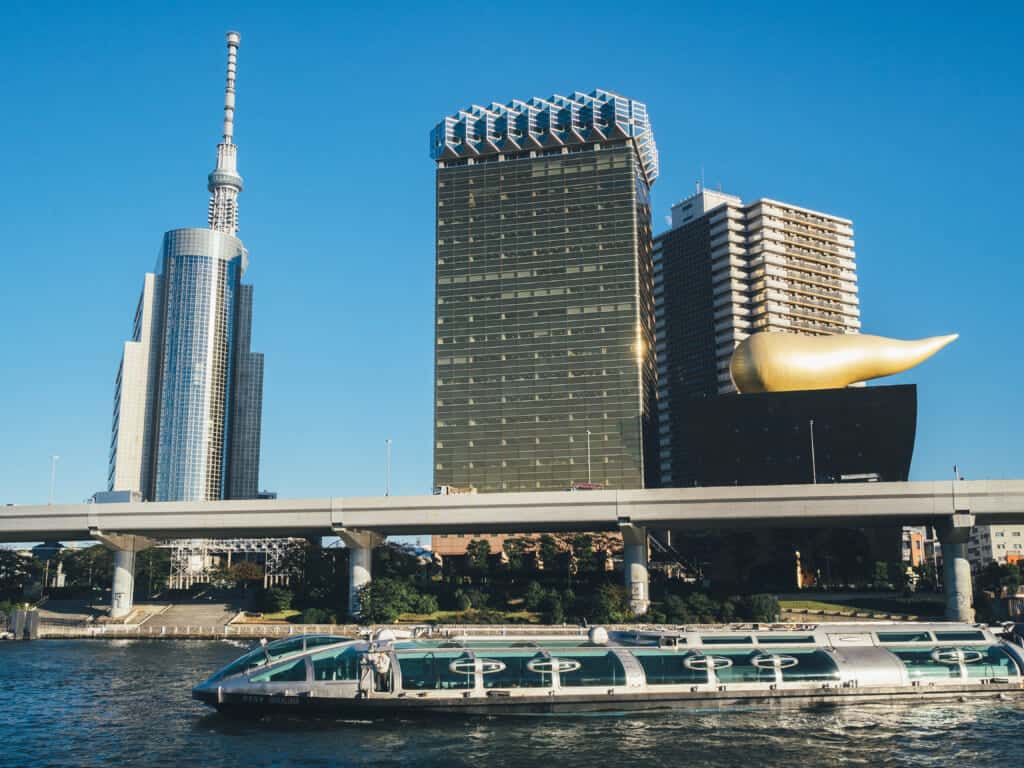
End your cruise at Asakusa Pier and head across the river to the creative LATTEST Sports , one of Tokyo’s hippest and most innovative cafes. Down a shot or two of LATTEST’s rich espressos and use that extra energy getting a workout on their bouldering wall. If you’d rather watch than participate, rest your heels in their huge sandbox, complete with soft white sand imported from an Australian beach.
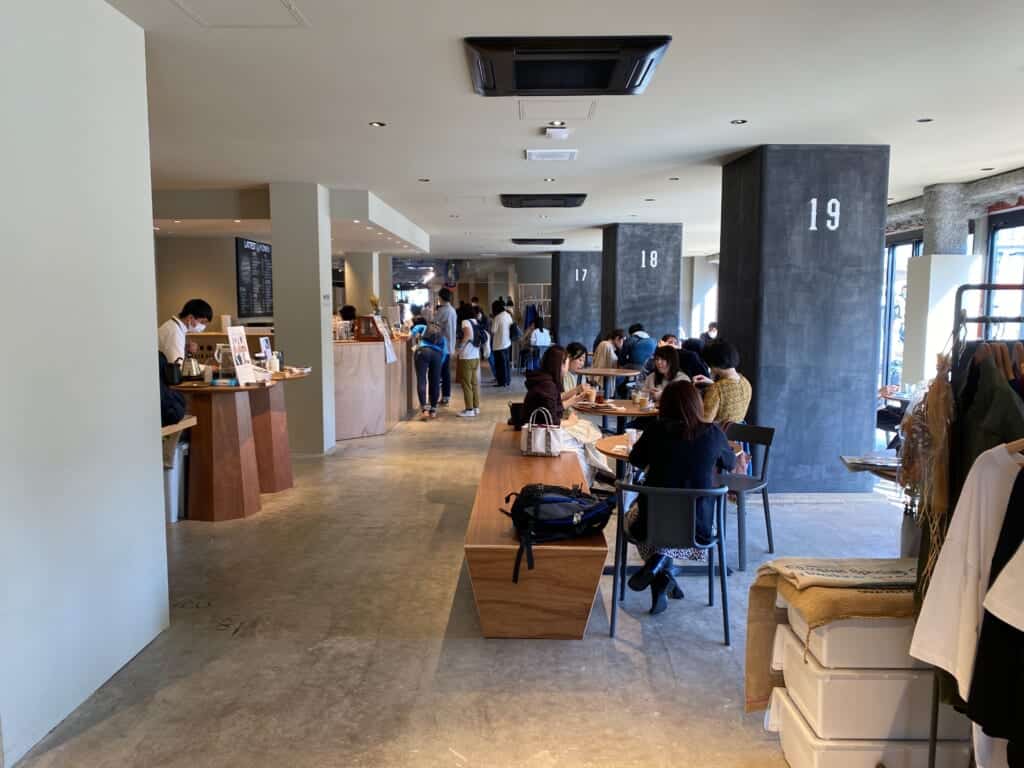
For a taste of luxury, the Ukai group of restaurants offers several locations with a diverse offering of cuisine but sharing the company’s standard of high-quality ingredients and East-meets-West modern luxury stylings. Choose from locations in upscale Ginza , Omotesando , or Roppongi neighborhoods serving teppanyaki featuring Japanese black wagyu beef and French-inspired cuisine, or kappou kaiseki meals using seasonal ingredients sourced from all over the globe paired with the finest Japanese sake and wines.
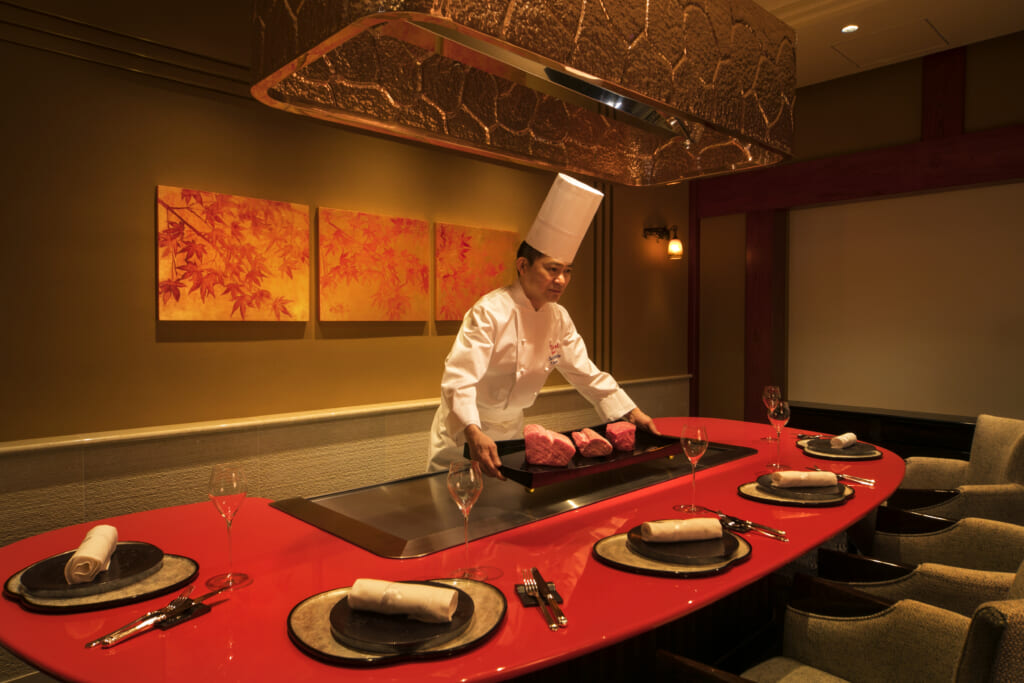
Alternatively, dine at Hinokizaka in the upscale The Ritz-Carlton, Tokyo. Chef Hisao Ishida pushes the boundaries of Japanese cuisine by procuring the best seasonal ingredients he can find from around Japan and preparing them in a way that his guests can enjoy through all five senses. Choose from four distinct areas serving different types of cuisine: sushi, tempura, teppanyaki, and kaiseki.
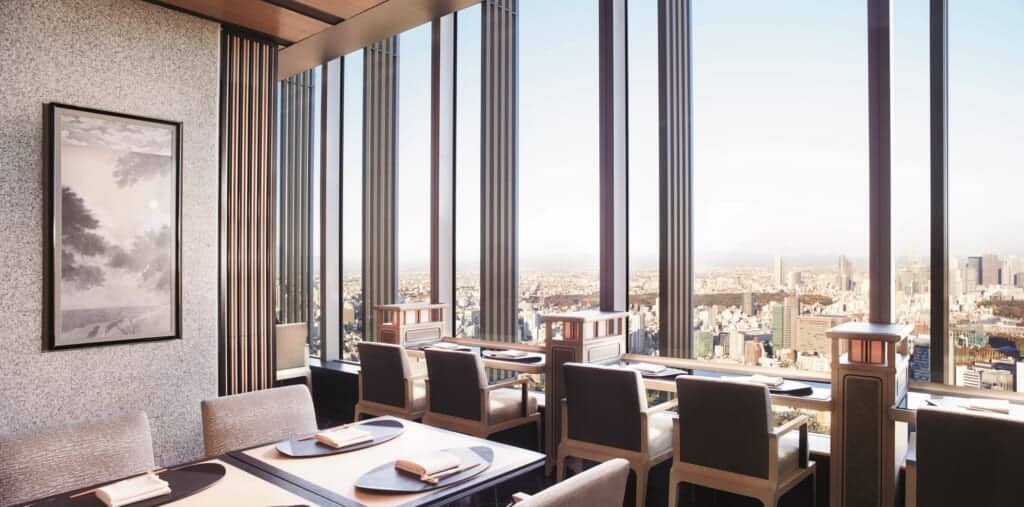
Nagano: Japanese Alps, Hiking, and More Beyond this Winter Playground
Leaving the big city behind, let’s venture out into Nagano Prefecture, best known for its abundant destinations for winter sports and the host of the 1998 Winter Olympic games. But Nagano isn’t just a winter playground, as you’ll soon see.
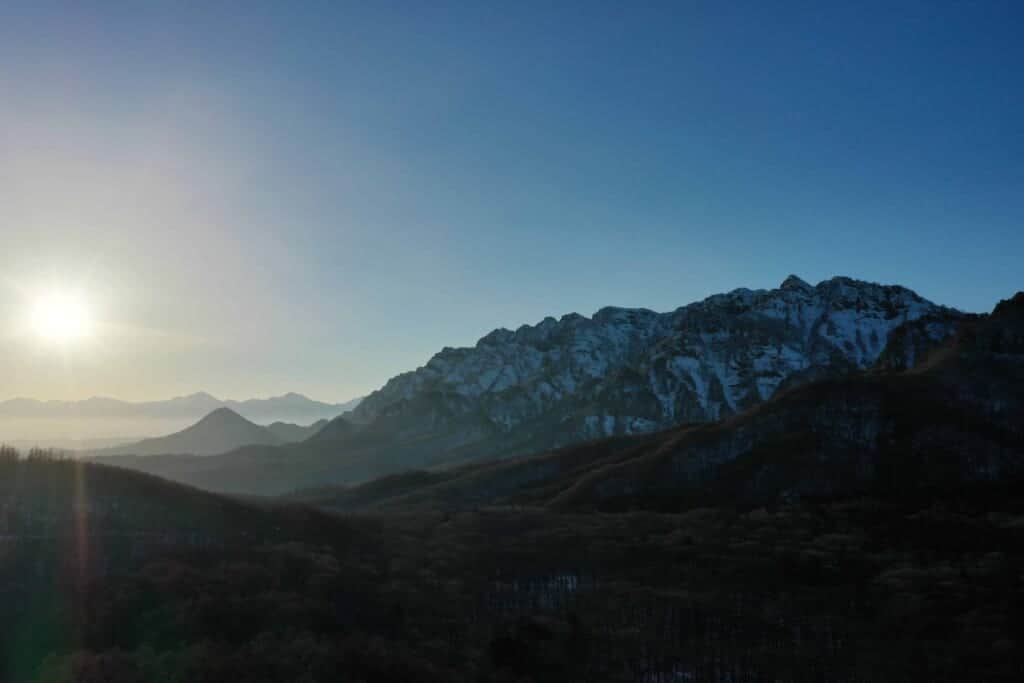
Snow Peak Field Suite Hakuba Kitaone Kogen is a mouthful of a mountain resort where you can enjoy panoramic views of Japan’s Northern Alps from foot to peak at its luxurious glamping facility. You’ll experience the hospitality of a resort hotel, including a dedicated concierge and gourmet cuisine while staying under the stars in either a generously proportioned tent or “living box suite,” a variation of a mobile house designed by renowned architect Kengo Kuma. Pass the time experiencing Nagano’s great outdoors by hiking, soaking in natural hot springs, or taking in the breathtaking views of the night sky.
Only Nagano Prefecture can lay claim to containing all three of the Japanese Alps: Northern, Central, and Southern. As such, it is a paradise for trekkers of all levels of experience . Beginners often enjoy the lower portion of Kamikochi along the Azusa River Basin, where panoramic views of the Northern Alps craggy peaks can be seen reflected in placid ponds of spring water. Experienced climbers can tackle multi-day treks like Mt. Yarigatake, the 3,180 meters high Matterhorn of Japan. Dozens of expeditions lie in between the skill levels needed for these treks, as well as adventures on mountain bikes, backcountry powder skiing, and more. At the end of the day, soak your tired body in one of the areas many onsen hot springs facilities.
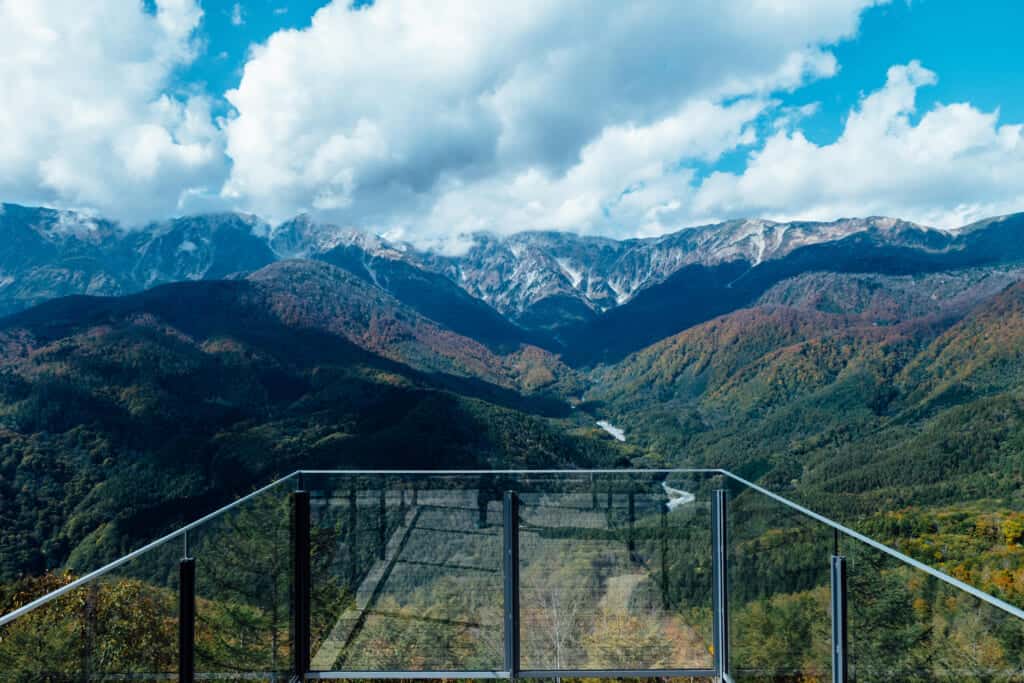
One such location to enjoy a hot springs bath is Sakaya Hanare Jonnobi , located in Nozawa Onsen, one of Japan’s most famous onsen towns. This ryokan features seven detached, three-bedroom units with a living/dining area and a full kitchen. Large enough for eight people to stay comfortably, it makes a perfect base for exploring the natural beauty of Nagano or participating in winter or green season adventure activities. If you’d rather not make your own meals during your stay, the resort features the Gibier Kitchen and Bar, serving fresh game meats paired with Japanese sake and wine.
Oumei-tei Tsuji Ryokan is another Japanese inn featuring mainly Japanese-style rooms, relaxing baths, and tranquil views of the onsite Japanese garden. Over a thousand years of history can’t be wrong as visitors to the nearby Togakushi Shrine used this location for lodging from Japan’s 6th century Nara era until the late 19th century. The local buckwheat soba noodles are made and served here, along with the seasonal foods provided by nature in this corner of paradise.
Gifu: Stunning Waterfalls and Cycling in the Japanese Countryside
Moving on to Gifu Prefecture , sustainability-conscious visitors are afforded the opportunity to explore a primeval forest, Goshikigahara , known as the last unexplored region of Japan. Choose from six different courses, three half-day, and three full-day, to destinations including stunning waterfalls, crystal ponds, and along roaring mountain streams. Goshikigahara Forest has a reservation system limiting the number of hikers to ensure minimal impact of humans on the delicate ecosystem, so this exclusive experience will earn you bragging rights with your friends back home.
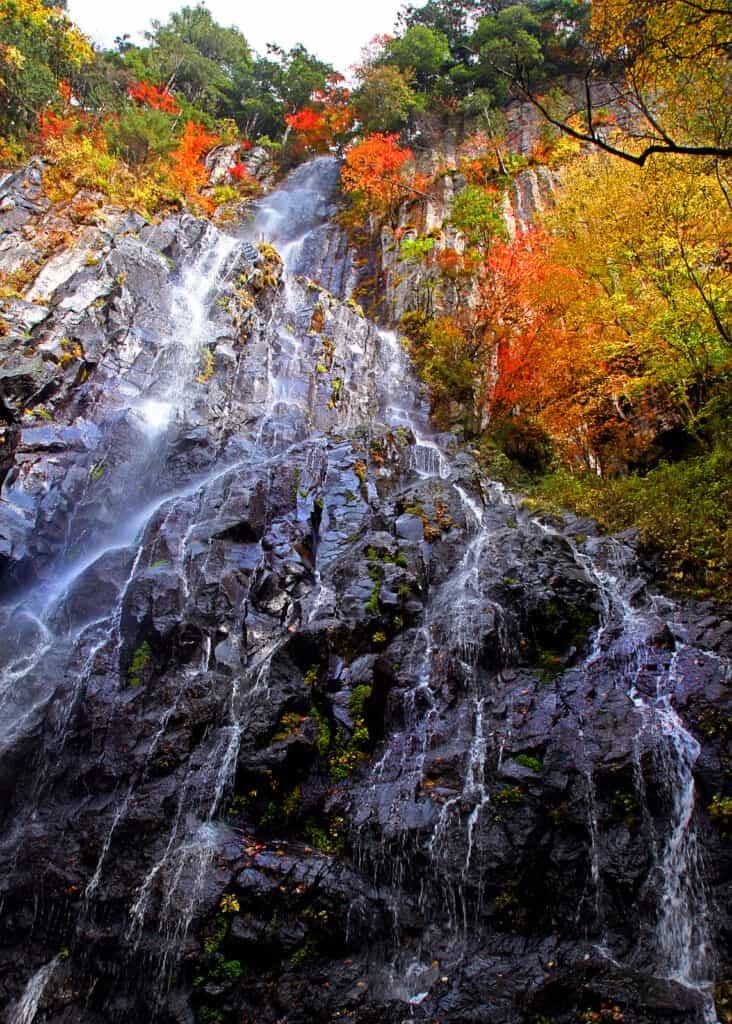
For a deep dive into the culture and lifestyle of mountain villagers, get in the saddle and let Satoyama Experience take you on a guided cycling tour of the Hida countryside. As you ride, your guide will explain the history and culture of the area, as well as bring you to places to view the most beautiful scenery. In the winter, take a snowshoeing tour instead, heading into the backcountry that you can only enter during the snow season. Satoyama Stay is a modest yet modern inn that integrates the area’s craftsmanship, architecture, and natural resources. Using the resources of the local people including homecooked meals and local ingredients, you can truly experience what it means to live local.
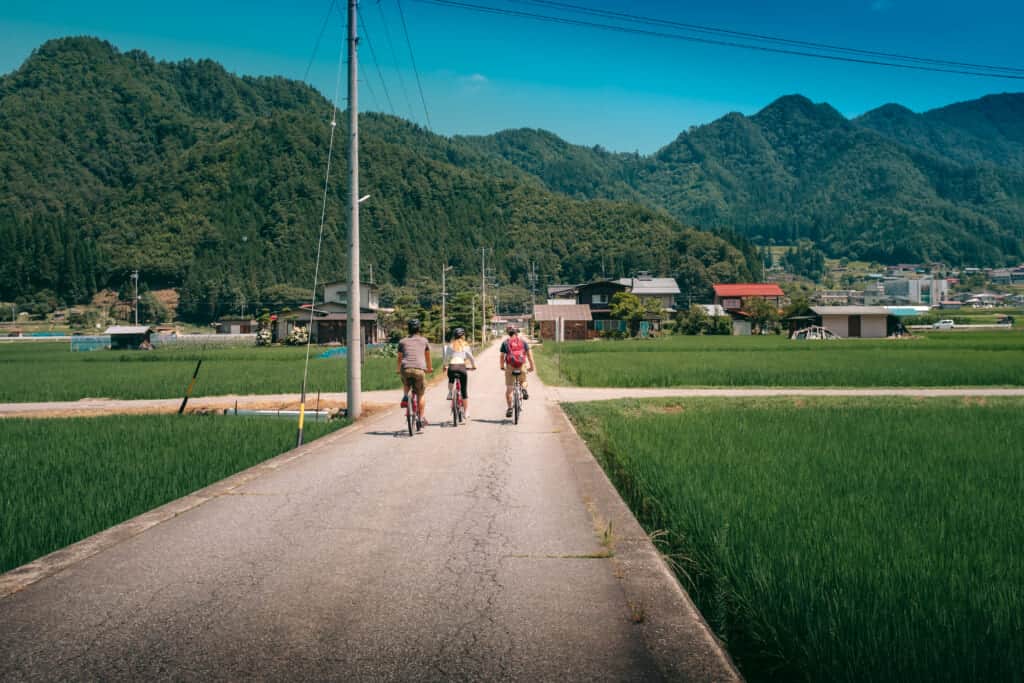
A more luxurious side of Gifu can be found in the area collectively known as Okuhida Onsengo , five onsen hot spring resorts high in the Northern Alps. The plentiful open-air rotenburo baths offer a unique opportunity to take a hot bath surrounded by mountains covered in pure white powder snow or lush green forests, or better yet, under the countless stars visible in the heavens at night. Enjoy a meal at one of the many hotels, inns, and spas in the area and feast on local delicacies such as the coveted Hida beef.
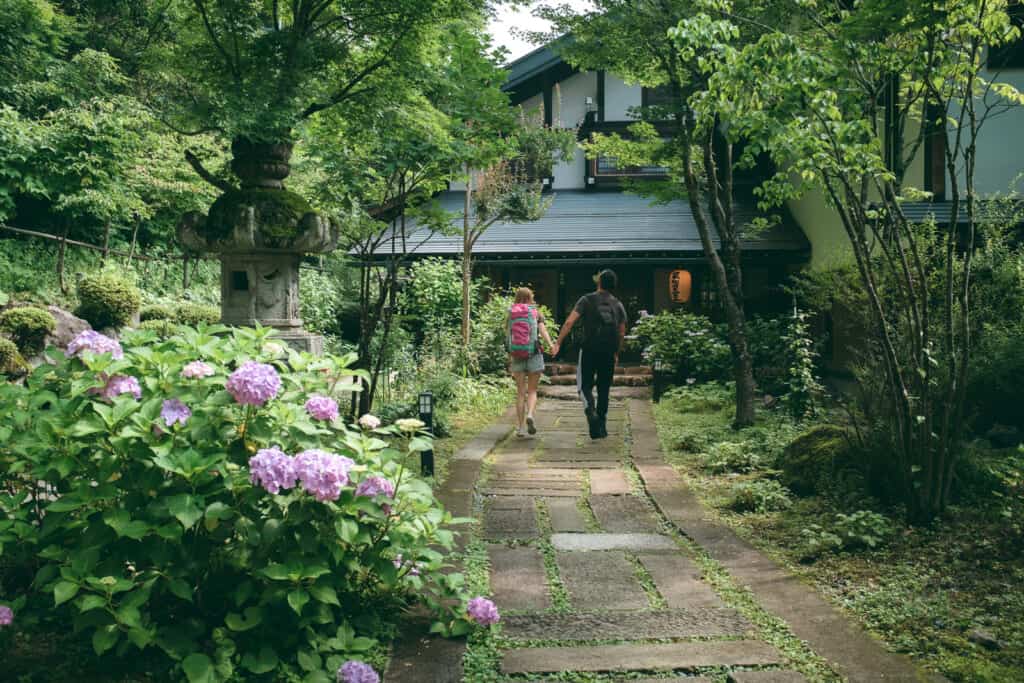
Hida beef is a brand of wagyu beef raised in Gifu. The meat benefits from pure water, clean air, and extreme seasonal temperature differences giving it a delicate flavor, soft texture, and detailed marbling. Try it as a sirloin steak, in a delicious pot of sukiyaki, or grilled yakiniku style over an open flame. You’ll find Hida beef at many fine establishments around Gifu, including the Okuhida Onsen area.
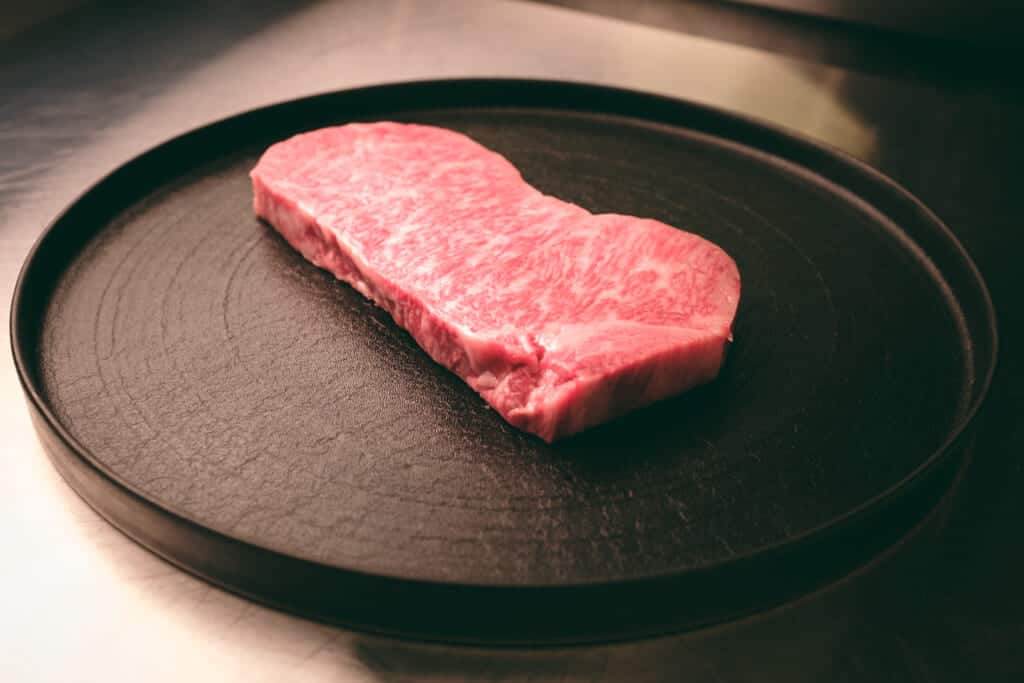
Ishikawa: Pristine Natural Landscape, Farmstays, and Spiritual Santuaries
Continuing our journey through Hokuriku, let’s move on to Kanazawa, the capital city of Ishikawa Prefecture. Art and culture were highly cultivated by the Maeda clan, who ruled over the province from Kanazawa castle, the effects of which can still be seen in modern culture, including the local cuisine.
In Kanazawa, let’s not just eat Kanazawa’s delicious local dishes; let’s learn how to make them! Omi-cho Market Tour & Kanazawa Cooking Experience is an experience that first takes you shopping in Omicho Market, the center for fresh seafood and vegetables for local residents for centuries. Once you have toured the market and procured your ingredients, a local chef will teach you how to make a meal from them while simultaneously explaining the city’s rich history. When the lesson concludes, it’s time to enjoy the fruits of your labor!
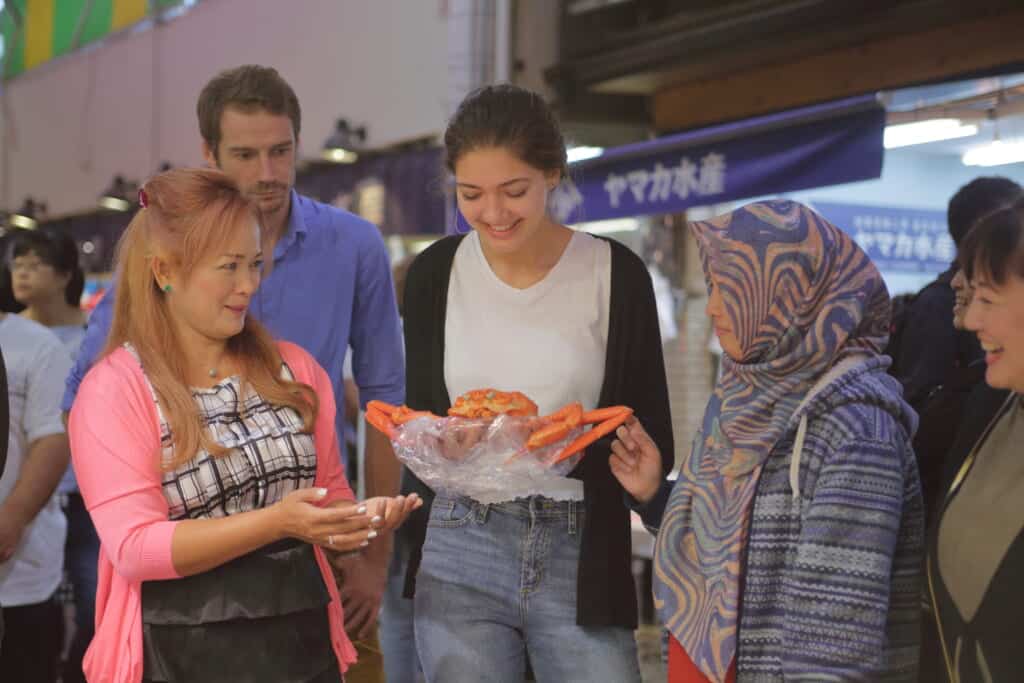
If this brief experience has only whet your appetite for experiencing the countryside life of Ishikawa, Shunran-no-Sato is sure to appease you. This authentic farm stay experience in the mountains of the Noto peninsula allows you to stay overnight in a farmhouse, eat home-cooked meals around the hearth, and even participate in traditional farming activities like vegetable or rice harvesting, mushroom picking, or making pickled vegetables. It’s also a rare chance to engage with the warmhearted local people casually to learn about their everyday life and perhaps build lasting friendships.
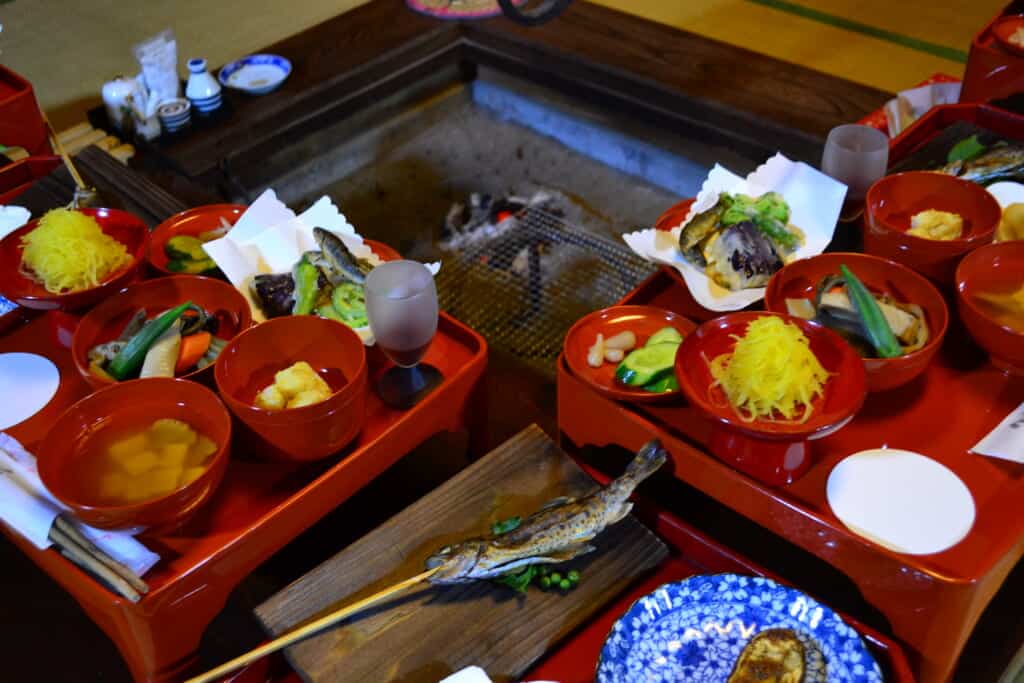
A different sort of unique accommodation is Ikumo , a mountaintop lodge in Komatsu nearby Natadera Temple. This secluded sanctuary is literally above the clouds on certain days, giving it an air of peacefulness that is a welcome respite from the news of the world. Guests can add a spiritual experience, where they can participate in meditation, yoga, and sutra copying.
The inn itself was constructed taking into consideration its pristine location and regard for nature, using recycled rainwater and solar power to minimize its ecological footprint. The Japanese and Western-style rooms have sweeping views, and the warm hearth and open-air bath are perfect places to pass the time slowly.
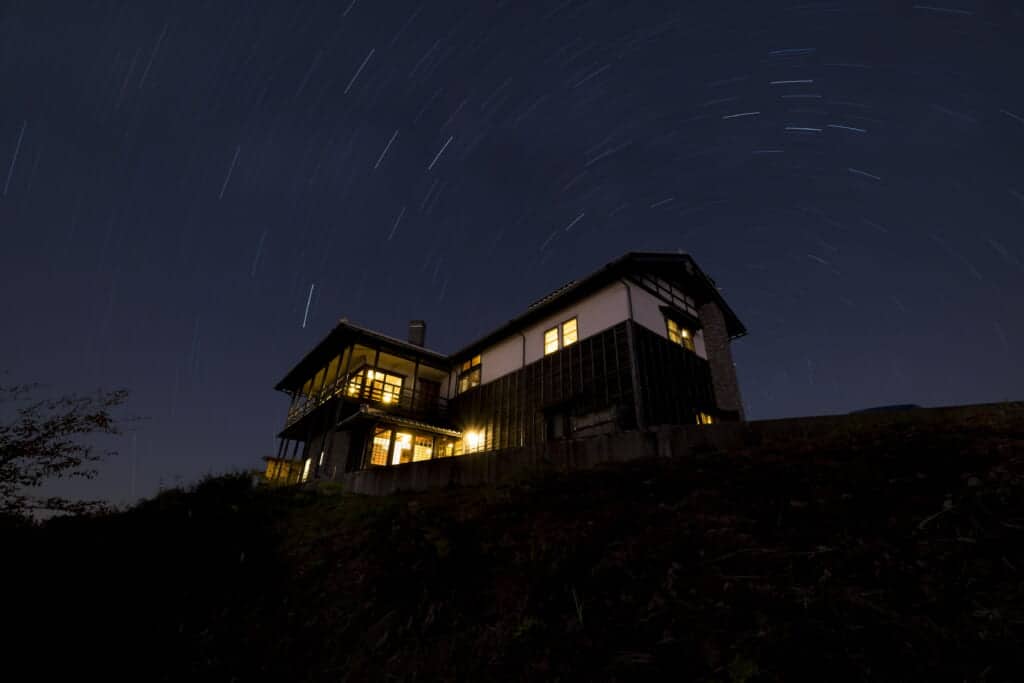
While exploring the area around Kanazawa city , be sure to experience the local cuisine, Kaga ryori . This unique style of food evolved from the high importance placed on art and culture in Kanazawa and is served on tableware that are works of art themselves: Kutani ceramic plates and Wajima and Kanazawa lacquerware. The food itself is considered a fusion of Eastern and Western Japan due to Kanazawa’s strong trade routes with both regions. Unique dishes to Kanazawa include jibuni , a hotpot made with tender slices of duck meat.
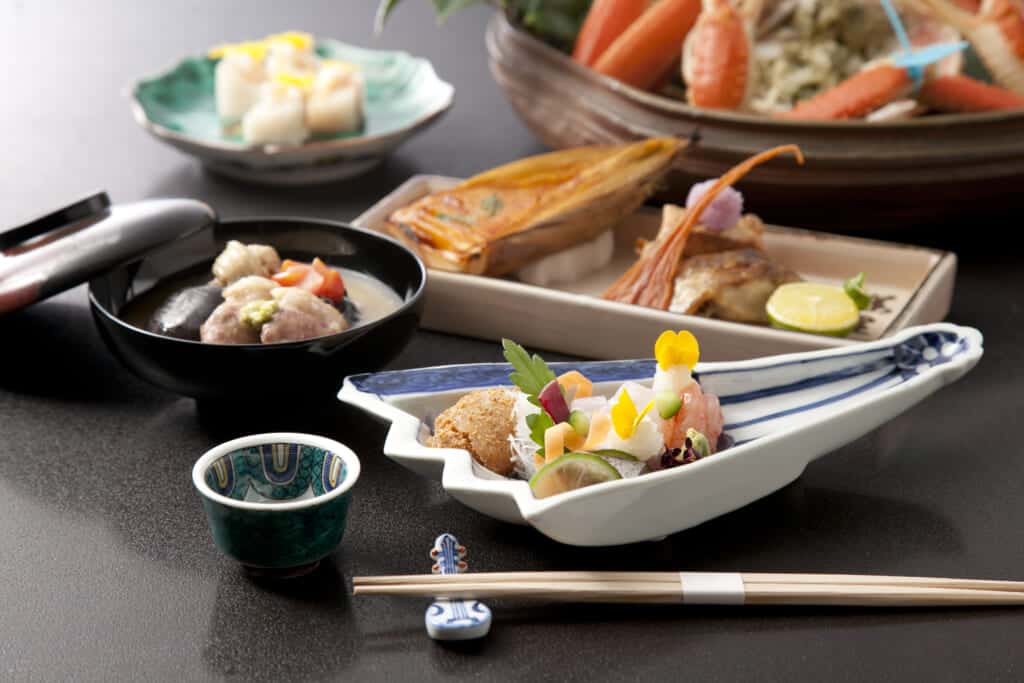
Fukui: Outdoor Adventurers’ Dream with Treetop Obstacle Courses and Ski Resorts
From luxurious meals to treetop accommodations? This can only mean we are heading to Fukui Prefecture, where the one-of-a-kind Tree Picnic Adventure Ikeda awaits. Spend the night on a platform suspended above the forest floor in a tent and wake up to an incredible sunset over the trees in the morning. After enjoying a day of optional activities such as whitewater rafting, treetop obstacle courses, or zip-lining, have your own BBQ party with meat and veggies provided by the park for dinner. For larger groups or those who prefer to sleep at ground level, the park also has cabins and cottages.
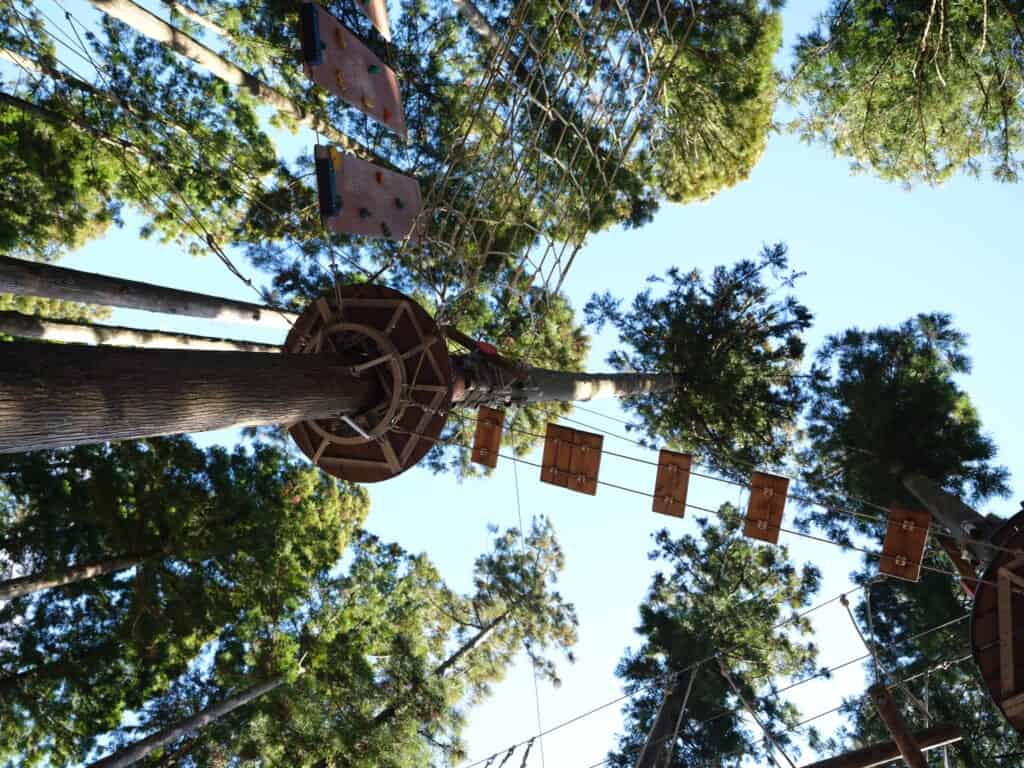
If your trip to Fukui takes place during the snowy months in Japan, be sure to visit Ski Jam Katsuyama , the largest ski resort in western Japan. With 14 runs spread over three mountain parks, Ski Jam has enough varied terrain to satisfy every level of skier and snowboarder. Lessons conducted in English are also available. After enjoying a day on the slopes, relax in the hot spring baths of the facilities directly connected to the resort.
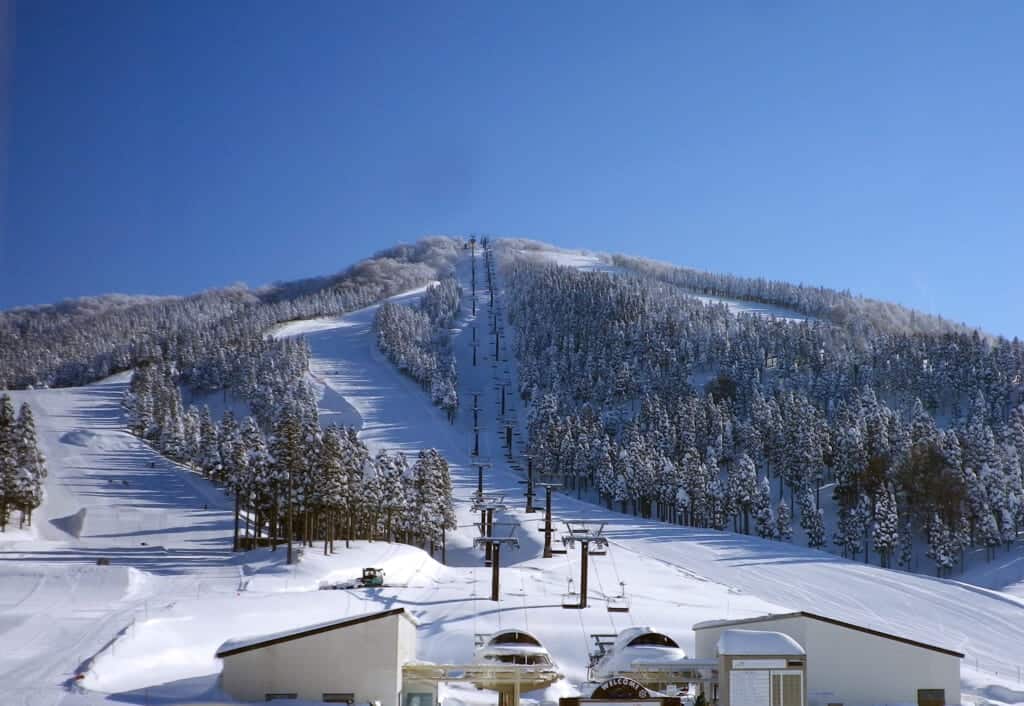
For those looking for a little more zen in their lives, perhaps a stay at the Hakujukan Hotel of the famous Eiheiji Temple is in order. The expansive Eiheiji Temple complex is an active Buddhist monastery nestled in the mountainous cedar forests east of Fukui city. Within a separate facility and with all of the comforts and conveniences of a traditional Japanese inn, guests of Hakujukan can also partake of the more spiritual aspects of the temple, such as sumptuous Buddhist vegetarian meals, morning sutra recitals, and meditation sessions. Hakujukan even offers a trained “Zen Concierge” to guide you on the various zen activities offered by the hotel and temple.
The majority of Japan’s snow crab comes from the Sea of Japan, and Fukui boasts their own brand, Echizen crab, as a favorite delicacy of winter. Echizen crab is so renowned for its flavorful meat that it is the only crab presented to Japan’s Imperial Family as a gift. Crab season opens in early November and continues until the end of March, so if your visit coincides with these dates, be sure to order Echizen crab at one of Fukui’s fine restaurants.
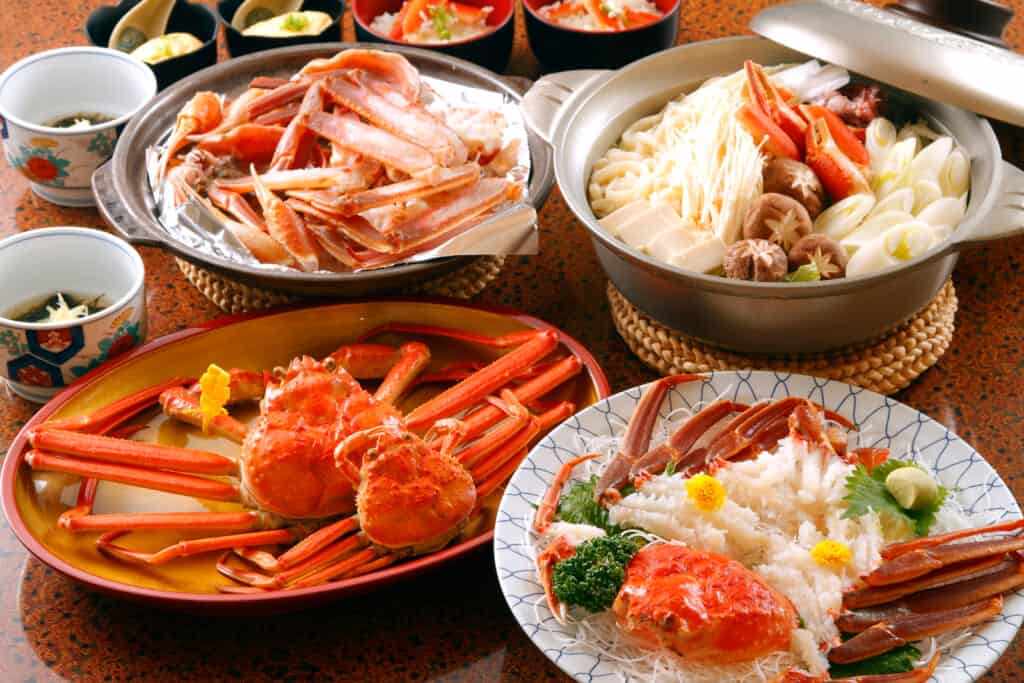
After Fukui Prefecture, you’ll finally enter Kyoto, but before making a beeline for the bustling former capital city, take some time to explore what the rest of the prefecture has to offer. You’ll be glad you did.
Kyoto: One of Japan’s Three Best Views, Stand-up Paddleboarding, and Forest Maintenance
Most visitors to Japan don’t realize that Kyoto has a coastline and a beautiful one at that. “Kyoto of the Sea” is the nickname for this area, which includes Amanohashidate, one of the 3 major views of Japan . To fully appreciate the beauty of the region, explore it on a Stand-up paddleboard (SUP) , enjoying the incredible hues of the blue-green ocean beneath your feet. A variety of SUP experiences are available here, including lessons on the basics, ranging from one to three hours in length. Sea kayak experiences are also available as another option for getting out on the “Tango blue” waters of Kyoto.

While you’re in the area, have a relaxing overnight stay at Kasyouen Hotel , with its stunning views of Yugihaura Beach, recognized for having one of Japan’s top 100 sunset views. Each room has a view overlooking the sea and is a hybrid Japanese-Western style with beds and private baths. But don’t neglect to use the hot spring bath here, where the naturally alkaline waters will leave your skin feeling silky smooth and soft. The included meals are based on seasonal ingredients such as winter crab, spring abalone, autumn matsutake mushrooms, and Kuroge-wagyu beef.
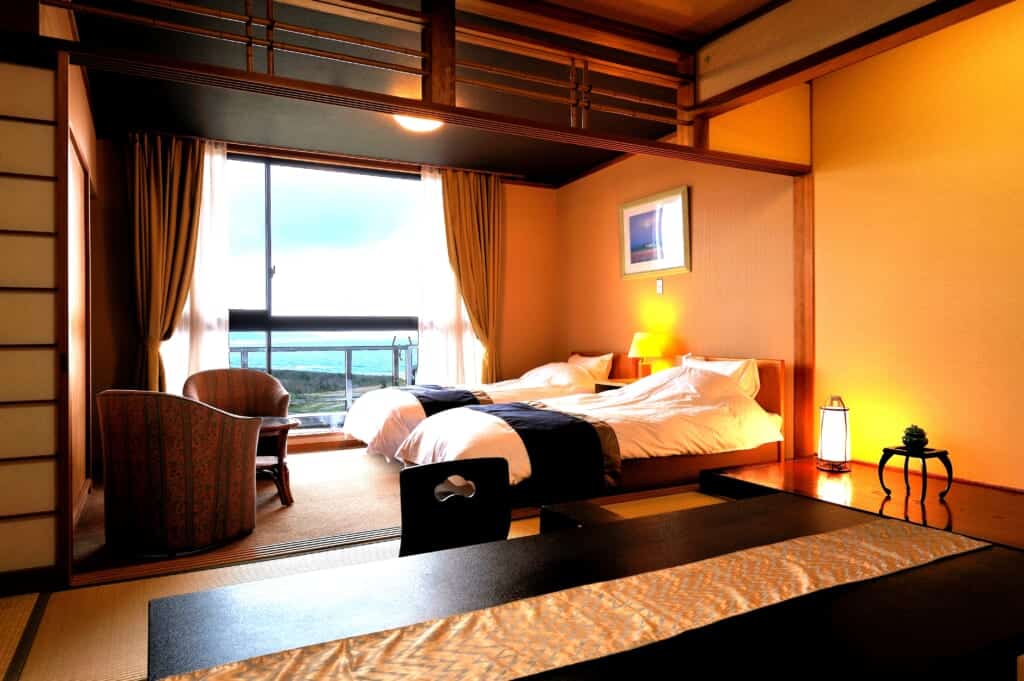
Kyoto may be famous for its history and Buddhist temples, but dig a little deeper and you will find a different side in northern Kyoto. Here, time flows at a leisurely pace in this traditional Japanese countryside landscape, with a variety of local experiences offered via the Kitairo experience tours website. Spend the day with a Kyoto Fukuchiyama mountaineer learning about forest maintenance in Japan and making “wood candles” with your own hands using a chainsaw. At an old Kominka private house, you’ll use the wood candle to cook a satisfying lunch outside and enjoy eating it in the comfort of the house. This hands-on experience would be special in any location, but especially in Japan, where forestry and sustainable logging are fundamental concerns for many areas, with Kyoto Fukuchiyama city’s Kitairo acting as a bridge to carry this onto future generations.
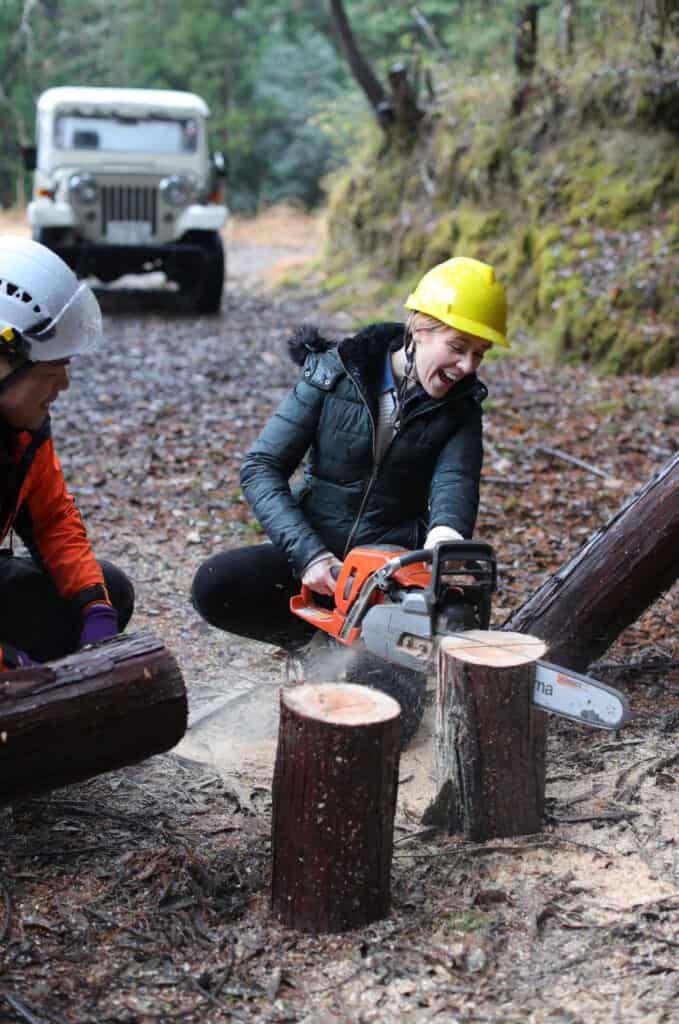
One final stop before making your way to the elegant city of Kyoto; a visit to Uji, home of the world-famous Uji matcha tea. Retreat to the luxurious Hanayashiki Ukifune-en , less than 20 minutes south of Kyoto Station. Pamper yourself with massage service and sauna before enjoying an exquisite meal at their kaiseki-style restaurant, Satori, or steakhouse Hanayashiki. The hotel is located near many UNESCO World Heritage sites, including the unparalleled Byodoin Temple, where you can experience a Japanese tea ceremony in the heart of Kyoto’s tea country. The seasonal beauty of Japan is pronounced in Uji, with incredible views of cherry blossoms, autumn foliage, and green summers, so anytime is the right time to visit here.
Paid Partnership with

Taking the New Golden Route through Hokuriku might be more leisurely than a direct bullet train from Tokyo to Kyoto, but you’ll find the time you spend in each of Hokuriku’s distinct prefectures time well spent. Japan Rail even offers a special Hokuriku Arch Pass offering 7 days of unlimited travel between many destinations included in this itinerary using the Hokuriku Shinkansen and other local train lines. Download the official pamphlet of the New Golden Route for more information.
Sponsored by Hokuriku-Shinetsu Transport Bureau, Tokyo Metropolitan Government, Nagano prefecture, Gifu prefecture, Ishikawa prefecture, Fukui prefecture, and Kyoto prefecture
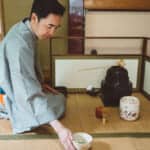
Freelance writer, photographer, and mentor. Japan-based, Oaktown (Oakland, California) born. Freelance writing and photography work includes Lonely Planet, Voyapon, Metropolis Japan, and many regional tourism websites around Japan.
https://www.toddfong.com
Recent Articles

Tokyo Skytree: The City from a Whole New Perspective

Leave a Reply Cancel Reply
Save my name, email, and website in this browser for the next time I comment.
I have read and accepted the Privacy Policy *

About Voyapon
- Privacy Policy
Affiliate Links
Some of our articles contain affiliate links. Whenever you use these links to buy something, we earn a commission to help support our work at Voyapon. Please read our disclosure for more info .
- Sightseeing
- Accommodation
- Things to Know
Destinations
Japan travel guide.
- Transportation
- Money in Japan
- Connectivity
- Getting Help
© 2024 VOYAPON. The images and contents of this site may not be used, reprinted or reproduced without permission.
Kyoto: Getting there and around
Getting to kyoto.
- ¥ around 14,000
- multiple trains per hour
Tokyo and Kyoto are connected with each other by the JR Tokaido Shinkansen . Nozomi trains require about 140 minutes to reach Kyoto from Tokyo, Hikari trains about 160 minutes and Kodama trains about four hours.
The regular one way fare from Tokyo to Kyoto is 13,320 yen for a non-reserved seat or around 14,000 yen for a reserved seat. The Japan Rail Pass is valid on Hikari and Kodama trains, but requires a supplement fee of 4,960 yen on Nozomi trains.
The Tokyo-Osaka Hokuriku Arch Pass is a rail pass that allows holders to travel between Tokyo and Kyoto via Kanazawa , using the Hokuriku Shinkansen . It is not the fastest way to travel between Tokyo and Kyoto, but it allows pass holders to visit the less-explored Hokuriku Region along the way. It costs 30,000 yen and is valid for seven consecutive days.
- ¥ 4,000 - 10,000
- multiple daytime and overnight connections per day
The one way trip from Tokyo to Kyoto by highway bus takes about 7-8 hours. There are daytime and overnight buses. Fierce competition on the Tokyo-Kyoto-Osaka route has produced a wide variety of comfort levels (from discount to super premium buses) and an abundance of low priced offers.
Typical one way fares for discount buses, such as Willer Express , start from around 4000 yen; while premium buses charge up to 10,000 yen. If used effectively, the Japan Bus Pass can reduce the cost for the bus trip to around 3000 yen. Online reservations can be made through Willer and Japan Bus Online .
- 2-3 transfers
- ¥ 11,000 - 32,000
- multiple flights per day
The closest airport to Kyoto is Osaka 's Itami Airport , about one hour by bus from central Kyoto ( more details ). Most flights connect Itami Airport with Tokyo 's Haneda Airport , with just a few serving Tokyo's Narita Airport . Flight duration is one hour. The regular one way fare is around 31,000 yen, but discount tickets are usually available for around 10,000 to 15,000 yen.
- ¥ around 10,000 (expressway tolls)
Driving between Tokyo and Kyoto via the Tomei and Meishin Expressways takes about five to six hours without breaks and traffic jams. The expressway toll is around 10,000 yen one way.
- 4 transfers
- ¥ 2,410 - 8,360
By local trains , the one way trip from Tokyo to Kyoto takes about nine hours and typically involves about four transfers of trains. The regular fare is a relatively expensive 8360 yen, however, with a Seishun 18 Kippu you could theoretically do the trip for as little as 2410 yen.
Above fees and schedules are subject to change. Be sure to check current yen exchange rates .
Getting around
Kyoto features a rectangular street system. Unlike the streets in other Japanese cities, most of central Kyoto's streets are named. The main streets running from east to west are numbered in ascending order from north to south, and are about 500 meters apart from each other, with several smaller streets in between. For example, Shijo means "4th Avenue" and Nijo means "2nd Avenue".
Kyoto's city center with the highest concentration of dining, shopping and entertainment opportunities, is located around the junction of Shijo-dori (4th Avenue) and Kawaramachi-dori (Kawaramachi Street). JR Kyoto Station is located south of the city center at the height of Hachijo-dori (8th Avenue).
The most prominent north-south street is Karasuma-dori (Karasuma Street), which runs from Kyoto Station via the city center to Kyoto Imperial Palace . Another north-south axis is Kamo River, about one kilometer east of Karasuma-dori.
Kyoto has a rather inadequately developed public transportation system for a city of its size, consisting of two subway lines, a dense bus network and several railway companies, whose lines are not always conveniently connected with each other. Taxis and bicycles can be worthwhile alternatives.
The recommended way to get around Kyoto by public transportation is to use an IC card , such as Icoca, which is accepted on virtually all trains and buses in the city. Alternatively, travelers intending to use buses or subways extensively, should consider one of the 1-day passes available. See the ticket section below for more details.
Below is a simplified map of the railway and subway lines of Kyoto:
Few of Kyoto 's tourist attractions are located close to subway or train stations. Instead, Kyoto has a dense bus network with direct bus lines from Kyoto Station and/or the city center around Shijo-dori and Kawaramachi-dori to most major sights.
Kyoto is served by multiple bus companies. For central Kyoto, the green Kyoto City Bus buses are most numerous and useful. The red buses by Kyoto Bus are second most prominent and tend to be convenient to access sights in more outlying areas of the city.
The tourist offices provide a useful English network map for the Kyoto City Buses, which makes it quite easy for foreign visitors to access tourist attractions by bus. Despite the good map and English displays and announcements, however, getting off at the correct bus stop can still be stressful, especially in crowded buses.
Since buses are small and operate surprisingly infrequently even on some major routes, buses to major tourist sights can often get crowded, especially on weekends and during holidays. In addition, much time can be lost when buses get stuck or only proceed slowly in the busy street traffic. Consequently, it is recommended to use subways and trains as much as possible, and use buses only for medium and short distances, for example, from the closest subway station to the destination.
Most buses are entered through the back door and left through the front door. The fare has to be paid when leaving the bus. Inside much of central Kyoto, there is a flat rate of 230 yen per ride. Outside the flat fare zone, the fare increases with the distance. Click here for more information on riding buses.
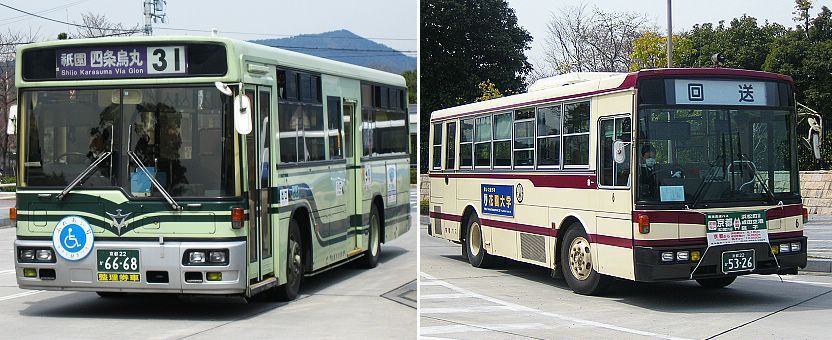
There are two subway lines in Kyoto , the Karasuma Line which runs from south to north along Karasuma-dori and stops at JR Kyoto Station, and the newer Tozai Line which runs from east to west and meets the Karasuma Line at the intersection of Karasuma-dori and Oike-dori.
Japan Railways
All JR lines, including the Tokaido Shinkansen , pass through or commence at JR Kyoto Station . JR trains can be a convenient for accessing the Arashiyama area (JR Sagano Line) and some attractions in southern Kyoto along the JR Nara Line, e.g. Fushimi Inari Shrine and Uji .
Other Railways
- Hankyu Railway connects Kyoto with Osaka . The line initially runs below Shijo Avenue from Kawaramachi westwards in direction of Osaka. It is a good option for accessing the area around Katsura Rikyu , from where a branch line also connects to Arashiyama .
- Keifuku Railway (also known as Randen) operates two tram-like train lines in northwestern Kyoto. For train lovers, a ride on these trains is a small attraction by itself. The lines can be an option for accessing Arashiyama and the area around Ryoanji and Kinkakuji .
- Keihan Railway 's main line runs next and parallel to Kamo River, but unfortunately does not connect to Kyoto Station . The line continues to Osaka and is an alternative to the JR Nara Line to access some of the attractions in southern Kyoto.
- Eizan Railway operates two train lines from where the Keihan Line ends, Demachiyanagi Station. One line leads to Kurama , while the other runs to the base of Hieizan .
- Kintetsu Railway connects Kyoto Station to Nara . Note that some trains on the Karasuma Subway Line continue to run on the Kintetsu Nara Line and the other way around.
By sightseeing bus
The Sky Hop Bus is an expensive but convenient way to visit Kyoto's most famous sightseeing spots. Double-decker buses with an open-air second floor run clockwise every hour from Kyoto Station in a large circle around the city, stopping near major tourist sites along the way, including Nijo Castle , Kinkakuji , the Imperial Palace , Heian Shrine and Kiyomizudera . A 1-day pass costs 4000 yen and a 2-day pass costs 6000 yen and can be purchased through Klook .
Kyoto is probably the Japanese city with the highest concentration of taxis . Especially in the city center, taxis are found everywhere. Taxis can not only be a more comfortable, but also an economical alternative to buses on short to medium distances for groups of three or more.
Most taxis accommodate up to four passengers (not including the driver), while larger vehicles are able to accommodate an additional fifth passenger. The rate starts around 500 yen for the first kilometer and increases by 100 yen for every additional 250-300 meters traveled.
Kyoto City's simple layout and flat terrain make it easy and convenient to explore by bicycle . Numerous bicycle rental outlets can be found around the city, especially around major stations, such as Kyoto Station or in popular biking areas like Arashiyama . Typical rental prices are around 1000-1500 yen per day for basic bicycles and around 1700-2500 yen for electric assist bicycles. Some lodgings may provide their guests with bicycles for a small fee or for free.
Kyoto is generally a bicycle-friendly city with relatively easily navigable roads and a handful of cycling routes, most notably along Kamo River. Designated bicycle parking is often freely available around popular sightseeing spots. The situation is a little bit more challenging in the city center due to congested roads, crowded sidewalks and a lack of designated parking areas. Also, distances to some of the more outlying sightseeing spots should not be underestimated. For example, it is about eight kilometers (typically a 45-75 minute ride) from Kyoto Station to Kinkakuji or about ten kilometers to Arashiyama .
Passes and Tickets
See also our separate page about the various passes available for the Kansai Region .
The prepaid IC card available in Kyoto is called Icoca . It does not give you any discounts over regular tickets, but it makes the process of taking trains and buses easier, as you do not always need to buy a ticket for each ride. Icoca cards can be purchased through ticket machines at JR stations. Local non-JR railway companies offer their own IC card called Pitapa ; however, Pitapa is a postpaid card that works more like a credit card and is targeted at residents.
Icoca and Pitapa can be used on virtually all trains and buses in and around Kyoto (and most other major cities in Japan). Additionally, eight other IC cards from other major cities of Japan can also be used on the trains and buses of Greater Osaka and Kyoto, including Suica, Pasmo, Kitaca, Toica, Manaca, Sugoca, Nimoca and Hayakaken.
The Kansai One Pass is a special version of Icoca exclusively for foreign tourists that additionally qualifies for discounts at various attractions in the Kansai Region . It is available for sale at Kansai Airport and major railway stations in the Kansai Region.
Furthermore, the following one day passes are available for Kyoto :
- Kyoto Sightseeing Card (1100 yen) Unlimited use of Kyoto's two subway lines and most buses (including Kyoto City Buses, Kyoto Buses, JR buses and Keihan buses) in central Kyoto and outskirts, including Ohara and Daigoji on one calendar day. The pass also comes with discount coupons for selected sights in Kyoto. It can be purchased from ticket machines in subway stations, at bus ticket centers and from some hotels. The pass can pay off especially if you visit outlying areas such as Ohara . The downside is that, besides the subway lines, the pass does not cover any other trains which are often a convenient means of getting around.
- Kyoto Subway One Day Card (800 yen) Unlimited use of Kyoto's two subway lines on one calendar day. The card can be purchased from ticket machines at subway stations. It generally pays off if you use subways more than three times per day, however its value is restricted by the subway's limited coverage area.
Questions? Ask in our forum .
Links and Resources
Arukumachi kyoto route planner, kansai one pass, kyoto municipal transportation bureau, keihan railway, kintetsu railway, hankyu railway, kansai airport transportation, sky hop bus, enjoy cycling in kyoto, eizan railway, keifuku railway, hotels around kyoto.
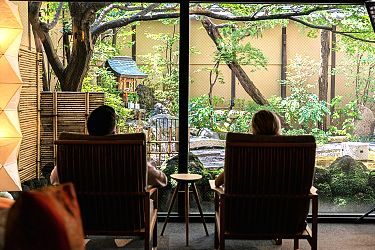
Experiences around Kyoto
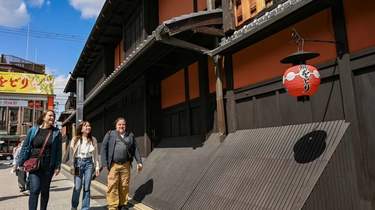
10% OFF - OCTOBER TO NOVEMBER TRAVEL
10-day round trip from tokyo to kyoto.
Tokyo and Kyoto are two of the must-see places in Japan and are separated by an hour plane ride or a 2.5-hour bullet train ride. However, in between lies so much that would be missed traveling by plane or train. Traveling by campervan is the perfect way to get the most out of your trip to Japan with campgrounds, roadside stations (michi-no-eki) and expressway parking and service areas providing a plethora of camping opportunities.
1500km trip distance
10 day roadtrip
Camper Van recommended
Izu Peninsula
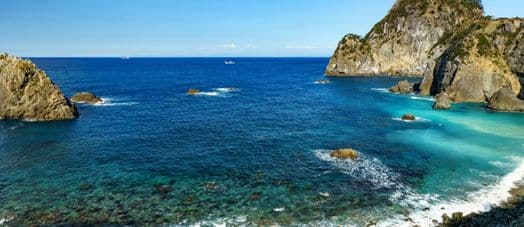
Located west of Tokyo, Izu Peninsula (Izu Hantō) is a popular area known for lovely coastlines which provide scuba diving opportunities, picturesque mountainous, hot springs, a mild climate, a great view of Mt. Fuji from the western coast of Izu Peninsula and much more.
If your trip brings you to Izu Peninsula between early February and early March, be sure to take in one of the festivals that celebrate the early blooming cherry trees that bathe the landscape in a sea of delightful pink.
For a free camping spot that features a nice view of Mt. Fuji, spend the night at Road Station Izu Gateway Kannami.
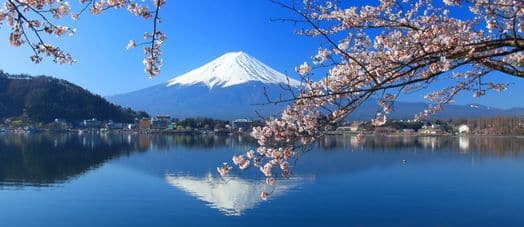
Standing at 3776 meters (12,389 ft.), Japan’s iconic symbol is a must see no matter the time of year. Spending some time in its vicinity will allow you to see some of its ever-changing moods. For those who are up for the challenge, take the night hike to the top and watch the sunrise (hiking season July- early September).
If hiking Mt. Fuji is not in your plans, there are still a myriad of options available surrounding the mountain, such as the Fuji 5 Lakes area which ranges from the northeast to the northwest of Mt. Fuji where five lakes are located with each having its own unique features and surrounding attractions and activities, a few of which include Fuji-Q Highland (amusement park), windsurfing on Lake Motosu, and Chureito Pagoda which offers splendid views of Mt. Fuji.
If children are with you, Fuji Safari Park located on the southern slope of Mt. Fuji is sure to please children of all ages.
Camping options are numerous with places such as Fukuzumi Auto Camping Ground near Lake Saiko having sinks and toilets.
Magome&Tsumago(Nakasendo)
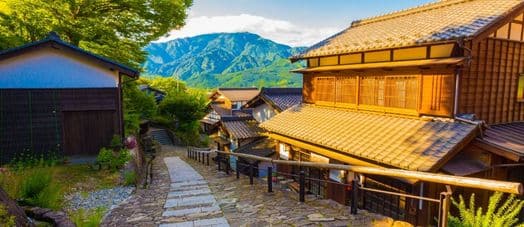
The approximately 2-hour one-way hike is a great way to step back in time as you journey between the open-air museum villages of Magome and Tsumago which served as post towns in the Kiso Valley during the Edo Era. Along the way enjoy the vibrant nature which includes the Otoko and Onna waterfalls.
If a roundtrip hike is not in your plans, there is a bus to take you back. For those not interested in hiking, the villages feature shops, restaurants, lovely photo opportunities and the chance to drift off into a time that one was.
Some camping options include Roman Valley Auto Campground, Hananoka Auto Camping Ground and Roadside Station Kirira Sakashita.
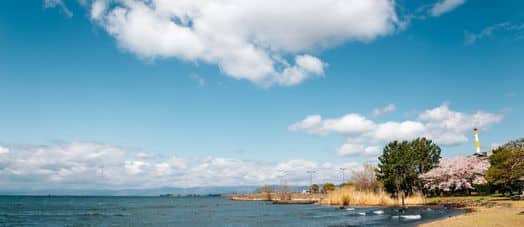
After all that you have seen and done so far, Lake Biwa, the largest lake in Japan, is a great place to take a break and catch your breath. On the eastern side you can visit Hikone Castle which is one of Japan’s remaining 12 original castles and the adjacent Genkyuen Garden.
Various campgrounds can be found around the lake along with several roadside stations.
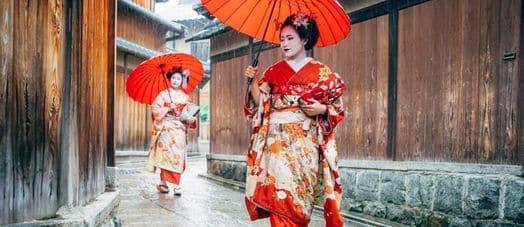
Kyoto, the ancient capital of Japan, with all its historical sites interspersed throughout the modern city is best enjoyed over a couple of days. Must-see places such as Kinkakuji (The Golden Pavillion), Kiomizu Temple, Inari Shrine, and the Arashiyama area will keep you looking for that postcard worthy picture. Many of these national treasures are illuminated at night during the cherry blossom and autumn foliage seasons creating awe inspiring sights.
Enjoy Kyoto’s unique dining experience in Pontocho the traditional and historical entertainment street.
As there are no campgrounds or roadside stations in the city of Kyoto, it is recommended that you park in a pay-parking area and use public transportation to navigate your way around the city.
The closest no-frills place to camp is Higashiyama Summit Park. Located on the northwestern side of Kyoto, it has free parking, restrooms and offers a spectacular night view.
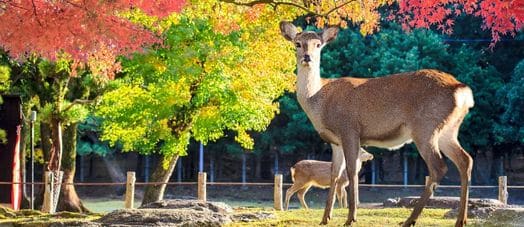
Nara, just south of Kyoto, is home to Nara Park. At 660 hectares, this park is home to Todiji Temple, one of the largest wooden structures in the world and home to a 15-meter-tall bronze statue of Buddha. The park also features other temples, a museum, gardens and some 1,000 deer that call the park home. The deer, which are considered sacred and are national treasures, roam freely through the park awaiting to be fed deer crackers.
Roadside stations and camping can be found in the area such as Resty Karoko-Kagi Michi-no-eki in southern Nara, Kardia Auto Camp south of Nara and Kasagi Camping Ground west of Nara.
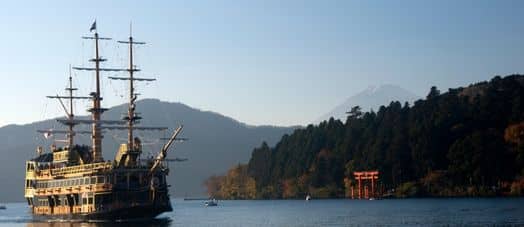
Break up the drive from Nara to Tokyo with as stop in Hakone. Located west of Tokyo and nestled around Lake Ashinoko with spectacular views of Mount Fuji, Hakone is a great place to relax as it is famous for hot springs and nature. Additionally, there are hiking opportunities, numerous types of museums, boat tours on Lake Ashino, Odwara Castle and more.
Camping options are a bit limited but include places such as Roadside Station Hakone Touge and Fun Space Ashinoko Camp Mura Lake Side Villa.
Return to Tokyo
Find Your Nearest Travellers Autobarn Location
Road trips & travel tips.
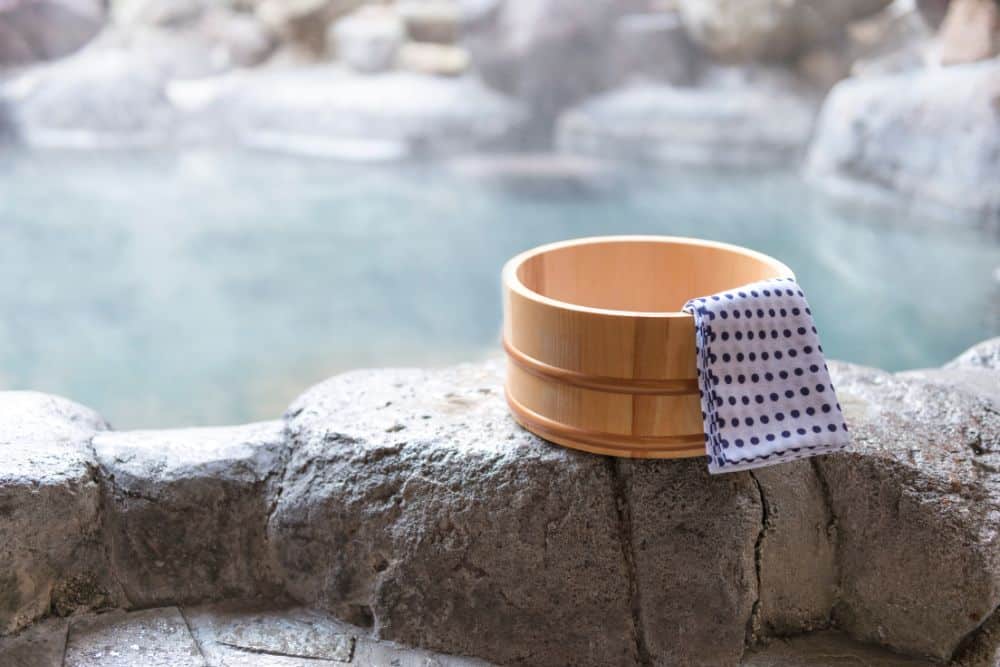
Hot Spring (Onsen) Areas/Towns Worth Visiting
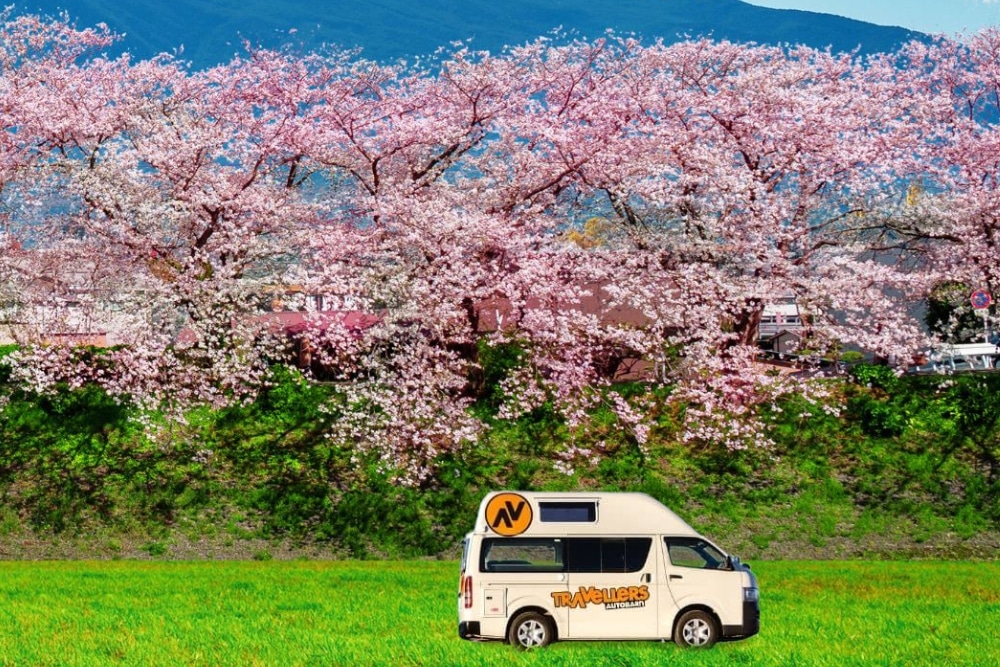
Enjoying Sakura By a Campervan Road Trip
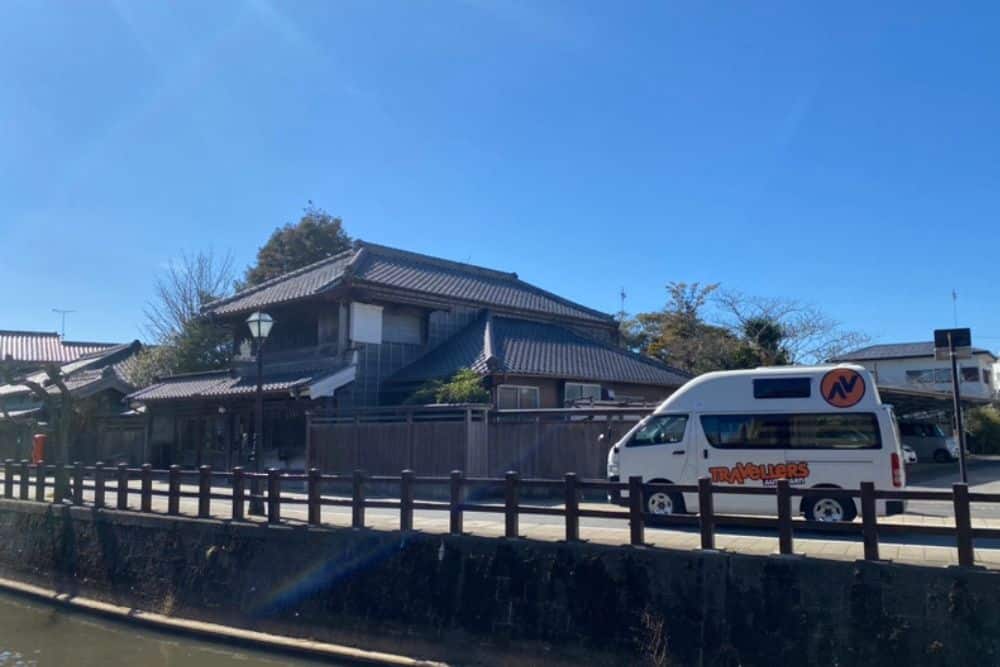
Everything You Need to Know about Campervans
Our campervans.
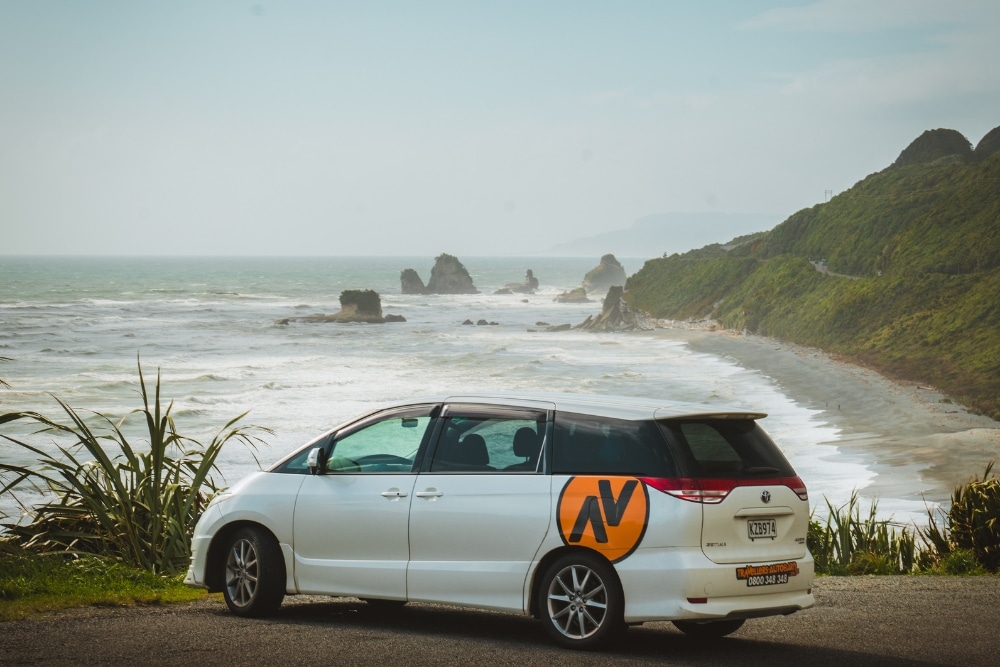
Station Wagon
Seats up tp 7.
Chairs Opt.
Gas Cooker Opt.

Kuga Campervan
Seats 2-3 (front seat) • sleeps 2-3.
Solar panel
Sign up for special deals and awesome road trip itineraries!
Data collection policy.

Destination:
Truly Tokyo
A Tokyo Travel Guide
How To Travel From Tokyo To Kyoto
It's very easy to travel between Tokyo and Kyoto. The shinkansen (bullet train) takes around 2 hours and 15 minutes and costs Y13,080. Read on for full details.

The Takeaway
- The shinkansen (bullet train) is the best way to travel between Tokyo and Kyoto.
- It takes around 2 hours and 15 minutes and costs Y13,080 between Tokyo and Kyoto(non-reserved seat).
- You don't need to reserve seats on the shinkansen if you travel outside of peak travel hours and outside of peak travel seasons.
- You can also purchase Tokyo to Kyoto shinkansen tickets online .
- See below for English-language shinkansen timetables.
- There are also night buses between Tokyo and Kyoto if you want to save money.
The Details
Shinkansen (bullet train) between tokyo and kyoto.
- The best way to travel between Tokyo and Kyoto is the shinkansen (bullet train). The fastest type of shinkansen, called the Nozomi, takes around 2 hours and 15 minutes and costs Y13,080 for a one-way trip in an unreserved seat. Note that you cannot ride the Nozomi shinkansen with a Japan Rail Pass , but you can ride the next fastest type of shinkansen, which is called the Hikari. The Hikari takes about 2 hours and 30 minutes between Tokyo and Kyoto, so it's almost as fast. Do NOT take the slowest type of shinkansen (the Kodama) as it stops a lot and is much slower.
- In Tokyo, you can catch the shinkansen at Tokyo Station or Shinagawa Station. All shinkansen stop at both stations. I like to get on at Tokyo Station because it's the first station so I can usually get a seat. However, if I'm coming from Kyoto and want to switch to the Narita Express, I sometimes switch at Shinagawa, because it's a short walk from the shinkansen platforms to the Narita Express platforms at Shinagawa and it's LONG hike at Tokyo Station. This would also hold true in the opposite direction (ie, if you want to switch between the Narita Express and the shinkansen and go straight to Kyoto, it's easier to switch at Shinagawa).
- In Kyoto, the shinkansen leave and arrive at the shinkansen platforms on the south side of Kyoto Station (clearly marked from everywhere).

Do You Need Reserved Seats on the Shinkansen?
- Normally, you don't need a reserved ticket to get a seat on the shinkansen. Just buy an unreserved ticket and show up and board the next shinkansen going your way. However, if you are traveling at rush hour (between 7am and 9am and 4pm and 7pm) or during peak travel seasons (31 Dec-3 Jan; the first week of May and mid-August), consider buying reserved tickets in advance. With a Japan Rail Pass, you can make reservations at any JR ticket window, up to one month in advance of your travel. You cannot reserve from overseas. HINT: If you have unreserved tickets and you find that the unreserved cars are full on the next train heading out, just stand in line at the boarding spot for the next train so you can board it first – this will usually guarantee a seat and you probably won't have to wait more than 15 minutes. If you book shinkansen tickets through an online agent like Klook, you can make seat reservations when you buy your ticket.
Check Hotel Availability
Destination, check-in date, check-out date.

First and Last Shinkansen Departures
- During the day, there are several shinkansen every hour between Tokyo and Kyoto. You rarely have to wait more than 10 minutes for a train. The approximate first and last departures are listed below:
- Westbound (Tokyo-Kyoto): 6:00am first / 7:50pm last
- Eastbound (Kyoto-Tokyo): 6:14am first / 9:30pm last
Shinkansen Schedules and Timetables
- English-language shinkansen timetables: JR Central English Site
- English-language timetable and route search: HyperDia
Willer Express Bus Between Tokyo and Kyoto
- If you're on a tight budget, you can save a lot of money by taking a Willer Express bus between Tokyo and Kyoto. These buses take around 8 hours and cost about Y7,000. In Tokyo, these buses operate from the Willer bus terminal in West Shinjuku. In Kyoto, these buses operate from Gion Shijo Station. For more information and online ticket purchase in English, visit the Willer Express Bus site .
JR Night Bus Between Tokyo and Kyoto
- Another cheap option for traveling between Tokyo and Kyoto is a JR night bus. These night buses take about 7 hours and 30 minutes and cost an average of Y9,400. In Tokyo, they leave from the JR bus terminal outside the Yaesu South Exit in front of Tokyo Station. In Kyoto, they leave from the JR bus terminal in front of Kyoto Station. Unfortunately, there is no English-language site for JR highway buses. So, for inquiries and ticket purchase, go to any JR ticket window or any travel agent in Japan. There is, however, a Tokyo - Kyoto Night bus service available to book online via Klook.
Tokyo Vacation Checklist
- For all the essentials in a brief overview, see my First Time In Tokyo guide
- Check Tokyo accommodation availability and pricing on Booking.com and Agoda.com - often you can book with no upfront payment and free cancellation
- Need tips on where to stay? See my one page guide Where To Stay In Tokyo
- You can buy shinkansen (bullet train) tickets online from Klook - popular routes include Tokyo to Kyoto , Tokyo to Osaka and Tokyo to Hiroshima
- You can buy a Japan SIM card online for collection on arrival at Tokyo Narita or Haneda airports. Or rent an unlimited data pocket wifi router
- See my comprehensive Packing List For Japan
- Compare airline flight prices and timings for the best Japan flight deals . Check my guides to arriving at Narita Airport and at Haneda Airport .
- If you're visiting more than one city, you might save money with a Japan Rail Pass – see if it's worth it for you
- A prepaid Welcome Suica card makes travelling around Tokyo much easier - here's how
- World Nomads offers simple and flexible travel insurance. Buy at home or while traveling and claim online from anywhere in the world
Tokyo District Map

- Imperial Palace Area
- Tokyo Station
- Shimbashi Shiodome Hamamatsucho Shinagawa
- Akihabara Kanda
- Roppongi Akasaka
- Harajuku Aoyama
- Ebisu Daikanyama Meguro
Disclosure: trulytokyo.com is a participant in the Amazon Services LLC Associates Program, an affiliate advertising program designed to provide a means for sites to earn advertising fees by advertising and linking to amazon.com and amazon.co.uk. World Nomads provides travel insurance for travellers in over 100 countries. As an affiliate, we receive a fee when you get a quote from World Nomads using this link. We do not represent World Nomads. This is information only and not a recommendation to buy travel insurance.
- Plan a Road Trip
- Plan a Flight
- Find an Airport
- Where to Stay
- All Questions
Kyoto to Tokyo drive
Kyoto to tokyo road trip planner.
Here's a sample itinerary for a drive from Kyoto to Tokyo. If you're planning a road trip to Tokyo, you can research locations to stop along the way. Make sure you check road conditions to double check the weather. Find the best hotels, restaurants, and attractions based on the most talked about places recommended by Trippy members.
11:00 am start in Kyoto drive for about 2 hours
12:56 pm Nagoya stay for about 1 hour and leave at 1:56 pm drive for about 54 minutes
2:50 pm Kenchōji Sugiyama stay for about 1 hour and leave at 3:50 pm drive for about 1 hour
day 1 driving ≈ 4 hours find more stops
11:00 am leave from Shimada drive for about 1 hour
12:06 pm Mt. Fuji stay for about 1 hour and leave at 1:06 pm drive for about 1 hour
2:10 pm Kamakura stay for about 1 hour and leave at 3:10 pm drive for about 54 minutes
4:04 pm arrive in Tokyo stay at The Peninsula Tokyo
day 2 driving ≈ 3 hours find more stops
Kyoto to Tokyo questions
Where should I stop along the way?
Nagoya (9 answers) questions about Nagoya: Where to find real local food in and around Nagoya? Internet (sim or portable wi-fi) Kenchōji Sugiyama Shimada Mt. Fuji (25 mentions) Kamakura (12 answers)
Where's the best place to stay in Tokyo?
Are you going straight to a hotel, or looking for a vacation rental or Airbnb?
The best resource on neighborhoods, areas, and hotels is the Trippy page on where to stay in Tokyo .
If you're looking for a quick answer, you can check out The Peninsula Tokyo , which was mentioned 5 times on Trippy.
Here are some more hotels people talk about:
Want to research more popular hotels in Tokyo? Click the blue button below.
Where's the best place to eat in Tokyo?
Need some recommendations on somewhere to get food?
Trippy members suggest Golden Gai , which was mentioned 6 times.
Here are some more restaurants people talk about:
Want to research more popular restaurants in Tokyo? Click the blue button below.
What are some things to do in Tokyo?
This section could be endless, so rather than trying to suggest every local activity or attraction, we'll leave it open-ended.
These are some of the places people talk about on Trippy:
Of course, Trippy is the perfect place to ask questions because there's an entire community of travelers talking to each other and sharing tips and advice. Trippy is where you can get answers personalized for your tastes, budgets, trip dates & more!
For example, here are some questions people have asked about Tokyo. Click on any question to see answers from the community!
Click the button below to explore more questions and answers related to Tokyo.
Do I really have to go back home?
Yes, even this step is optional, because if you're on vacation who wants the trip to end? It's okay, you can start planning your next trip!
Want to plan the trip back? Get the reverse directions for a Tokyo to Kyoto drive , or go to the main page to plan a new road trip .
You can also compare the travel time if you're flying or driving by calculating the distance from Kyoto to Tokyo . Or get a full Kyoto to Tokyo flight plan .
Don't forget about exploring your own hometown with a staycation. You can also find some cool day trips or get away for a weekend.
And if you know Kyoto well, please help your fellow travelers and answer their questions about Kyoto!
More info on this route:
road conditions from Kyoto to Tokyo
places to eat
alternate routes
Google driving directions
You are using an outdated browser. Please upgrade your browser to improve your experience.
- Restaurants
- Best-of Guides
- My Favorites
- Subscribe to our newsletter
- TheFork prefered partnership
- TheFork partner restaurants
- Global - English - USD
- Exploring Six Popular Tokyo Neighbourhoods
Tokyo—one of the world’s largest cities. This time, we’ll be introducing various Tokyo neighbourhoods where restaurants and hotels from the MICHELIN Guide are concentrated. Let’s head off to explore Tokyo in search of new discoveries.
Travel Tokyo Neighborhood Guide Japan Editor's Pick

Eating delicious food. Enjoying shopping. Experiencing something new and exciting. Relaxing. Everyone has their own travel goals. And it’s no exaggeration to say that Tokyo offers places to achieve them all.
Read on to learn about the distinct aspects of six neighbourhoods as well as local restaurants and accommodations recommended in the MICHELIN Guide. Make a note of any hotels or restaurants that catch your eye.
Choosing the right location to suit your needs is the first step to a comfortable journey. And now, let’s go rediscover Tokyo together.
1. Shibuya and Yoyogi
2. marunouchi and yaesu, 4. roppongi and azabudai, 6. nihombashi.

Shibuya is always at the forefront of youth culture and trends. You’ll notice its powerful energy from the moment you arrive.
SHIBUYA SKY, located at 299m above ground, looks out across the Tokyo landscape. If you want to experience Shibuya’s culture in a bustling, lively atmosphere, start in front of the famous Hachiko statue and walk down Center-Gai Street .
Or to see the newest side of Shibuya, try Shibuya Scramble Square or Shibuya Stream. From there, you might enjoy setting off for the trendy Daikanyama district.
Or try walking in the direction of Harajuku, crossing through MIYASHITA PARK and Shibuya Yokocho, and experiencing sento public bath culture at Kosugiyu Harajuku under the HARAKADO shopping centre.
If you have time, stroll toward Yoyogi Park with a coffee in hand. As the atmosphere of the streets shifts and transforms around you, bask in the peaceful calm of lush greenery that you would never expect to find in the heart of the city.
TRUNK (HOTEL) YOYOGI PARK
Because of its emphasis on calm relaxation, this hidden urban oasis is only open to hotel guests. You can enjoy the rooftop pool year-round, with a charming seating area facing Yoyogi Park.
You’ll want to order a coffee to go at neighbouring Norwegian cafe Fuglen and relax leisurely.

Shibuya Stream Hotel
Directly connected to JR Shibuya Station, this hotel makes the perfect sightseeing base. In the basement level, you’ll find a cafe open from the early morning hours and restaurants open until late into the night, for unmatched convenience.

Daikanyama Issai Kassai
Within walking distance of Shibuya Station, this is a fun izakaya where you can enjoy creative Washoku cuisine.
Katsuo Shokudo
Many people visit this popular restaurant to enjoy the rice topped with generous portions of dried bonito flakes—shaved with painstaking care.
Head further down toward Yoyogi-Hachiman Station from an area called ‘Oku-Shibu ,’ follow the road, and you’ll notice a sweet fragrance hanging in the air. That scent and the line of people waiting to enter the restaurant will be your guides.
Kyoryori Aun
Back to the Contents

Running east-to-west, the vast Marunouchi and Yaesu area borders Tokyo Station, one of Japan’s most famous terminal stations.
We recommend taking a coffee break to watch the joggers circling the loop around the lush outer gardens of the Imperial Palace and enjoying a stroll down Marunouchi Naka-dori Avenue before or after a meal. With the pebbled pathways and grassy walkways, you’ll find yourself somehow wanting to breathe in deeply.
Tokyo Midtown Yaesu a symbolic tower is here too. Walking towards Nihonbashi offers a refined glimpse into Tokyo’s evolving landscape.
Bulgari Hotel Tokyo

Palace Hotel Tokyo
The Palace Hotel is located in the outer garden of the Imperial Palace. The guest rooms featuring balconies are rare in Tokyo.
MICHELIN Star Chinese Chugoku Hanten Kohakukyu (Amber Palace) offers authentic Cantonese cuisine prepared by a chef from Hong Kong. At One MICHELIN Star ESTERRE , you can indulge in French cuisine overseen by Alain Ducasse.

Kyobashi Tempura Fukamachi

Asakusa — the famed sightseeing destination that needs no introduction. Day or night, the area around Sensoji Temple is often bustling with crowds.
We recommend catching a rickshaw ride and exploring Asakusa. The apron-clad rickshaw pullers will tell you about famous sightseeing spots and share local anecdotes as they show you around, and even take photos for you at the best spots.
Kappabashi is a neighbourhood packed with shops related to cooking and kitchenware.
Standing on what was once a small hill, Matsuchiyama Shoden is a hidden gem surrounded by lush greenery. Head to Imado Shrine, famous for its auspicious Maneki Neko cats and matchmaking blessings. Both are famous Asakusa Shichi Fuku Jin Shrines honouring the seven lucky gods.
Because trains run directly from this area to both Narita and Haneda Airports, allowing you to reach either airport in about an hour, this spot is recommended for the beginning or end of your trip.
Asakusa View Hotel Annex Rokku

Asakusa Nagami
A Kappo restaurant in Oku-Asakusa. The owner-chef of Kyoto’s Two MICHELIN Star Kikunoi Roan showcases his culinary skills here.
The Kaminari Okoshi snacks with fried batter are unique to Asakusa. The casual banter creates a relaxed atmosphere, and the chef will make you a cup of hot tea to complete your meal.
A bistro located behind (‘no ura’) its parent restaurant, Two MICHELIN Star French HOMMAGE . Here you can enjoy traditional bistro cuisine such as duck breast confit and onion gratin soup.
The Taiwanese-style minced pork rice was created from a dish originally cooked for the restaurant staff. Half sizes are also available, and you can order add-ons even after finishing your course-style meal.
Onigiri Asakusa Yadoroku
A small onigiri restaurant with both counter and table seating. There’s always a long line of people waiting outside to taste these delicious rice balls.
You’ll be delighted by the owner’s lively chatter and deft hand movements, and your onigiri will be ready before you know it. You’ll want to snap a few photos and eat as much freshly prepared food as you can.
Sushi Kanesho

An area where you can experience art alongside enormous shopping centres.
Azabudai Hills is home to the Digital Art Museum from Team Lab and the Azabudai Hills Gallery.
At Tokyo Midtown, you can enjoy the current exhibition being held at 21_21 Design Sight.
Roppongi Hills is the site of the Mori Arts Museum. And with the National Art Museum, the Nezu Museum, and more, this area is packed with more art than you could possibly see in a single day.
Plus, thanks to direct connections from the station, you can easily access large shopping centres even in inclement weather. This area offers a wide range of options for shopping or relaxing at a cafe. Discover all that Tokyo’s Minato Ward, famed for its nightlife, has to offer during the day.
The Ritz-Carlton Tokyo

IRUCA TOKYO
Roppongi rian, nodaiwa azabu iikura honten.

From long ago to the present day, Ginza has always been a cutting-edge shopping area. Browse long-standing department stores like Mitsukoshi and Matsuya as well as newer shopping centres like GINZA SIX.
From noon until evening on weekends and public holidays, the Chuo-dori central street transforms into a pedestrian paradise with no cars in sight. You can even enjoy people-watching from the chairs set out in the street.
Why not head out toward Hibiya Park or walk through Yurakucho toward Marunouchi? Or you can keep following Chuo-dori Avenue to visit Nihombashi.
The streets of Ura-corridor under Shimbashi Bridge also offer a wide array of fascinating shops and restaurants to explore.
The Tokyo EDITION, Ginza

MUJI HOTEL GINZA

Ginza Yondaime TAKAHASHIYA
The main attraction of Takahashiya is the delicious eel-focused dinner courses. These courses showcase the wide-ranging appeal of eel that is not fully conveyed by a typical meal of grilled eel over rice.
A restaurant featuring vegetable-centric Japanese cuisine.
You’ll want to make the most of a night out in Ginza with chicken and wine.
Ginza Katsukami

In 1603, Nihombashi Bridge—completed just when the Edo Shogunate was first established—became the symbol of the prosperous Nihonbashi area, the centre of the Japanese economy. The concept of measuring distances from the Japanese road origin marker in Nihombashi to locations across the country also gained traction at this time.
Found amidst the countless buildings of the Muromachi area, Fukutoku Shrine is a spot you’ll want to visit. Take one step onto the grounds and you’ll be surrounded by a mysterious and dignified atmosphere.
If you’re an architecture fan, you should head out to Kabutocho, called Japan’s Wall Street. The grand and dignified stone buildings have new interiors now, but traces of the past still remain in the rows of fashionable cafes and shops.
A boutique hotel facing the Tokyo Stock Exchange in Kabutocho area. This building was formerly Japan’s very first bank branch, established by Eiichi Shibusawa.

Mandarin Oriental Tokyo
Offering convenient direct access to Mitsukoshimae Station on the Tokyo Metro Ginza Line, this hotel is located on the upper floors of Nihonbashi Mitsui Tower. This is the ideal luxury hotel to serve as a base for exploring Tokyo’s charming shita-machi areas on foot.

Yakitori Takahashi
Tempura asanuma.
Top Image: ⒸSean Pavone

3 Days in London
The Michelin Inspectors' top tips on where to eat, drink, stay and have fun in one of the world's busiest and most exciting cities

2 Days in Bordeaux and Saint-Émilion
Just 2 hours from Paris by train, Bordeaux is a haven for lovers of ancient buildings and fine wines. It's also just 30 minutes away from the village of Saint-Émilion, a beautiful UNESCO World Heritage Site. Discover our choice of the best non-touristy restaurants, bars, wineries, and hotels in both destinations.

Where Semma's Vijay Kumar Goes in NYC
From cheap eats to special occasions, the chef behind One MICHELIN Star Semma reveals his go-to spots.
Keep Exploring - Stories we think you will enjoy reading

Paris in Summer: 14 Must-Sees to Live Like a Local
In July and August, Paris is transformed into a seaside resort. Terraces, beaches, and swimming on the banks of the Seine... Open-air swimming pools, music festivals, and cinemas... For a successful weekend or extended stay in the City of Light, follow The MICHELIN Guide's recommendations!

Hackney: London's Hipster Paradise
Discover the best and trendiest places to eat and stay in Hackney, Shoreditch and beyond

Outstandingly Affordable Key Hotels in Spain
To gain a Key, hotels must represent outstanding quality in five categories. One of those? Value for price.

Beat the Heat at These 9 MICHELIN Hotels in Asia Where You Can Enjoy a Mountain Breeze
Here are nine hotels in Asia that take you away from the downtown bustle and into the cool mountain breezes.

Argentina: Chef Sebastián Weigandt’s Favourite Haunts in Mendoza
A culinary journey exploring the flavours of Mendoza through the eyes of Sebastián Weigandt, owner-chef of the one MICHELIN Star restaurant Azafrán, enabling you to discover markets, restaurants, hotels and bars chosen by a true gastronomic connoisseur.

2 New Three Star Restaurants in The MICHELIN Guide Nordic Countries 2024
Discover all the winners from Denmark, Finland, Iceland, Norway and Sweden

Where Daniel Boulud Goes In New York
The chef who has made Manhattan home for more than three decades spills on where he eats, drinks, and enjoys the city.

Seven of the Most Luxurious Hotels in Paris
There are nearly 1,500 hotels in Paris, spanning every need and desire. The seven below represent the absolute peak of service, accommodation and sheer extravagance.
MICHELIN Guide

Use the app to find the best restaurants and hotels everywhere
Be the first to get news and update about the michelin guide.
MICHELIN Guide selections
The michelin group.
- Terms of Use
- Privacy Policy
- Legal Notice
Display settings
Customize your experience by easily adjusting display settings for territory, and currency to suit your preferences!
Member privileges
The Plus program provides upgrades and amenities at participating hotels. For this hotel, Plus members will receive:
Non-members can add the privileges at checkout through our 30 day free trial, cancellable at anytime.

Best places in the world to see cherry blossoms
A fter a long gray winter, there are few things that can lift my mood like seeing the first pink cherry blossoms of spring filling the sky with their delicate blooms.
I'm especially lucky — some of the best buds on the East Coast bloom near me at Branch Brook Park in Newark (yes, that Newark ). The 5,000 trees create a cotton candy skyline for a week in early April that banishes all thoughts of bleak winter days.
I'm not the only one who feels the cherry blossoms' positive mood pull. The Japanese equate sakura , cherry blossoms, with new beginnings, and the act of hanami , or cherry blossom viewing, in early spring is met with both reverence and celebration in Japan, with multiple generations spending days and evenings at parties, picnics and festivals lauding this fresh new start.
Although Japan, especially Tokyo, is equated with hanami celebrations, you can find sakura in destinations around the globe. It's the perfect excuse to plan spring travel — a cherry blossom pilgrimage offers not just the visual spectacle of the blooms and their aftermath of soft silky petals covering the ground like fragrant snow, but a chance to immerse yourself in the culture of each destination, too.
Related: The best places to see cherry blossoms around the US this spring
Of course, trees can be temperamental depending on the weather, so build a bit of time buffer into your travels if you're planning a trip specifically around seeing the delicate pink and cream blooms and their flower fireworks.
From Amsterdam to Japan, here's where to immerse yourself in spring's sakura.
If you're considering traveling to see spring's cherry blossom bloom, chances are you have Tokyo in your sights already, since sakura are synonymous with this city, where the tradition of hanami dates back 1,200 years. The entire city celebrates the blooms with picnics and events, special sakura-themed menus, and hanami bento and snack spots near viewing areas.
There are multiple locations around Tokyo to view the pink sakura wave. Among the most prominent is Ueno Park, which transforms into a pink wonderland with 1,000 flowering trees that bring millions of visitors to bask in their rosy glow. In the evenings, the park is illuminated for a glowing nighttime visit. Another top stop is Chidorigafuchi Park, where the Imperial Palace is located, which is especially memorable for its nearly half-mile tunnel of blooms plus a sakura-lined canal that you can boat through.
According to Japan's cherry blossom forecast , Tokyo's blooms are predicted to start March 23 and be at full flower on March 30. (Once again, these dates can wiggle a bit depending on Mother Nature.)
Where to stay: Staying near major transportation hubs will make it easy to see sakura around the city (and not be stuck in the crowds at the most popular spots). The Conrad Tokyo occupies the top floors of the Shiodome skyscraper, with stellar views of Tokyo Bay, and is near several train stations. It's also next to Hama-rikyu Gardens, a hidden gem for peaceful sakura viewing. During peak hanami, the last week in March, rooms start at $818 or 95,000 Hilton Honors points per night.
Related: The best hotels in Tokyo for your next Japan getaway
Kyoto, Japan
It's not just Tokyo where the sakura are revered in Japan. Kyoto is also world-renowned for its surge of cherry blossoms that bloom just in time for spring and romantically outline the tranquil pathways of its many parks. Known as the cultural heart of Japan, and serving as the central preservation hub for Japan's vibrant culture and history, seeing the sakura among its 2,000 temples and shrines — including Nijo Castle and Toji Temple — truly imbues the ancient practice with a sense of history.
One particularly special spot is Philosopher's Path, which weaves through cherry tree-lined canals between the Ginkakuji and Nanzenji temples. It's a particularly serene setting for hanami. For evening viewing, Maruyama-Koen Park is especially popular for its illuminated branches and picnic areas under the bowers.
According to the Japan Meteorological Corporation, peak sakura viewing in Kyoto will start with the first blooms on March 23 and peak on March 31. The city sponsors multiple events, including night viewings.
Where to stay: The Park Hyatt Kyoto has a prime location in the Higashiyama ward and combines modern luxury with ancient pagoda guesthouse-style accommodations. (TPG staffers also love its French-inspired teppanyaki dining at Yasaka and its convivial bar, Kohaku, where craft cocktails are served with classic Kyoto views). Rates during hanami start at $1,273 or 35,000-45,000 World of Hyatt points per night, making it a great option for World of Hyatt loyalists.
Related: What's faster: Race from Tokyo to Kyoto by Japan Airlines plane and bullet train
Seoul, South Korea
The cherry blossom spectacle at Yeouido Hangang Park in Seoul is a must-see, and it doesn't have the same influx of foreign travelers that you'll find in Tokyo, so you can avoid some of the flower-viewing crush that's become part of the experience there. Some of the top viewing spots are Yeouido Park and Gyeongbokgung Palace, both of which have stunning views of clouds of blooms.
The Jinhae Cherry Blossom Festival is one of the biggest viewing events in South Korea. It takes place in early April and features parades and performances, including a magical night lantern parade. Although it's not in Seoul, it's possible to do a one-day excursion with Klook , where a bus will pick you up in the morning, take you to the festival and then bring you back in the evening.
Where to stay: The stylish Andaz Seoul Gangnam is centrally located, making it easy to walk to most of Seoul's main attractions; plus, there's direct access to Apgujeong station to reach the cherry blossom sites. Expect design details like bojagi, a traditional Korean cloth used to create textile art. The hotel has an array of hot tubs, a sauna and a lap pool. The property is a Category 5 World of Hyatt property; rooms start at $281 or 20,000 Hyatt points per night during the first week of April.
Related: A confluence of innovation and honored traditions: South Korea 2024
I am solidly in the camp that thinks Paris is always a good idea, especially in late March and the beginning of April when cerisiers (cherry trees) paint the town pink.
You'll find pockets of the pink flowers all around the city. Some top spots include near the Louvre at the Jardin du Palais-Royal, where you'll also spot spring daffodils filling the flower beds. You can also catch the pink wave along the Champ de Mars leading to the Eiffel Tower and in the Trocadero Gardens (the ultimate Instagram selfie with the tower and the pink petals). One of my favorite cherry blossom spots in Paris — Square Jean XXIII, next to Notre Dame — is currently closed, but it should be open for the 2025 flower season, if you're planning a trip for next year.
Unlike other destinations where you'll find cherry blossom events, there are no organized festivals in the City of Light. Do like the Parisians do, and plan a picnic under the flowering bowers.
Where to stay: The Hotel du Louvre, part of The Unbound Collection by Hyatt, is tucked in between the Louvre and the Jardin du Palais-Royal, so you'll have cherry blossom views no matter which way you turn when you walk out the door. For a double room in mid-April, the member rate with breakfast starts at $565 per night. This is a Hyatt Category 7 property, with point redemptions available for mid-April starting at 30,000 points per night.
Related: The best hotels in Paris
Although this might not be the biggest display in Europe, the cherry blossom season in Amsterdam has something that no other city can claim: a distinctly feminist feel. At Kersenbloesempark (Cherry Blossom Park) in Amsterdamse Bos (Amsterdam Forest) in Amstelveen , a suburb of Amsterdam located 5 miles south of downtown, the park's 400 trees, a gift from the Japanese Women's Club, are all named after women, with half in Dutch and half in Japanese.
There are no exact dates for the blooms, but expect about a two-week bloom sometime in late March or early April. Note that picnicking is only allowed during weekdays, and there are no restrooms in the gardens (check out the Amstelveen website for nearby restaurants).
Where to stay: From the centrally located Kimpton DeWitt Amsterdam , it's easy to both explore Amsterdam and to hop on tram line 5 to reach Amstelveen (about a 25-minute ride). IHG member rates for the hotel start at $231 a night in early April, with reward night stays starting at 31,000 IHG points. And as part of Kimpton's Plant Pals program, the hotel will deliver a plant, which has a name and name tag, to your room.
Related: How to spend 1 day in Amsterdam
Jerte Valley, Spain
Sure, it's impressive to see hundreds of cherry blossom trees together. And when you view thousands in one place, it's quite a sight. But how about millions of trees? That's what awaits in the Jerte Valley in the Extremadura region of Spain (about three hours west of Madrid), where more than 2 million cherry trees create a sea of petals in late March and early April.
During an extended celebration that runs from late March all the way into May, you'll find everything from special marketplaces to medieval fairs, plus music, culture and cuisine events centered around the blooms. Unlike the ornamental varieties of Japanese cherry trees, the ones here produce prized fruit. If you return in May or June, you can even join the cherry harvest.
Where to stay: The Jerte Valley enjoys a rural setting, and there are no opportunities for points redemptions here. However, there are some authentic and welcoming places to spend the night, including Hospederia Valle del Jerte, which has a historic exterior but modern rooms. There's an outdoor pool, a full breakfast and fantastic views of the valley, all for around $110 per night.
Washington, DC
As a former resident of the nation's capital, I can attest that Washington's nearly 4,000 Yoshino cherry blossom trees transform the serious, buttoned-up city into a veritable pink carnival during the short lifespan of the blooms.
In addition to the festival held March 20 to April 14, with everything from a parade to a kite festival to a "Petalpalooza," the Tidal Basin, where the majority of cherry blossoms are located, turns into a round-the-clock picnic scene, with thousands of people lying in the soft fallen petals, enjoying the spring weather.
Note that if you can't visit during the main peak bloom period, another variety of cherry blossom, the Kwanzan, usually blooms two weeks later in other parts of the city. And if you want to avoid the crowds, head to the National Arboretum for a much more relaxed viewing experience.
Where to stay: Hilton fans will want to head to the Waldorf Astoria Washington DC, which occupies the Old Post Office building. It's grand and very ornate, with a multifloor atrium and even a 19-foot cherry blossom tree in the lobby, where a Cherry Blossom Afternoon Tea is served. Special Cherry Blossom packages include a two-night stay, exclusive seating for the tea and special access to hanami locations around DC. Expect rates around $580 or 110,000 Hilton Honors points per night during the peak of bloom season.
Macon, Georgia
Here's a U.S. spot for hanami that may come as a surprise: Macon, Georgia. The Yoshino trees here were mistaken for the more popular dogwood when they were originally planted in 1949, according to city officials. Today, though, the annual bloom is celebrated in big style. For 10 days — this year, the bloom is predicted from March 15 to 24 — the entire city turns pink as more than 350,000 cherry trees are in full bloom (by comparison, Washington has 3,800).
This year a new event, The Pink Provisions Party on Poplar, on March 15, will feature local restaurants and bars presenting all of their signature creations for the celebration. Think cherry ice cream, pink doughnuts, foamy fuchsia cocktails, a cherry blossom pilsner from Ocmulgee Brewpub and even a cherry blossom coffee blend from Z Beans.
A live "Bloom Cam" feed allows those who can't make it to watch the cherry trees as they announce the arrival of spring.
Where to stay: Use your Marriott points to stay at Hotel Forty Five, Macon, a Tribute Portfolio Hotel . The new boutique 95-room hotel is right in the middle of all the pink party happenings, and you can check it out from the Hightales Rooftop Bar. Double room rates start at $216 or 39,000 Marriott Bonvoy points a night during cherry blossom season.
Vancouver, British Columbia
With more than 40,000 cherry trees, many of which came directly from Japan, Vancouver's Queen Elizabeth Park becomes a veritable puff of pink in the spring.
With so many trees comprising multiple varieties, the blooming period spreads over nearly two months, so if you're visiting in March or April, you will likely be able to spot some petals on the trees.
The Vancouver Cherry Blossom Festival will be held from March 29 to April 25 (almost a full month), with a mix of arts and culture events, including a Japanese Sakura Days Fair, a Haiku Festival and a Blossoms After Dark event for illuminated evening viewing.
Where to stay: Keep your stay green with a visit to the Fairmont Waterfront , whose organic rooftop garden grows everything from vegetables to fruit trees, not to mention beehives (you can try the honey at their "pollinator" dinner.) Room rates start at $299 a night in early April (Accor Live Limitless members receive 5% off the lowest rate).
Related: Booking the perfect Pacific Northwest summer vacation with points and miles
Victoria, British Columbia
Victoria boasts the mildest year-round climate in Canada, and as a result it's a haven for spring florals. Starting at the end of February and going until May, the city offers an incredibly extended, and impressive, cherry blossom bloom.
One of the most popular places to see the tapestry of pink hues is along the aptly named View Street in the heart of Downtown Victoria. It's usually the first area to explode in a sea of pink flowers, so this is a stop for early birds.
Although there's no formal festival, Victoria does have an interactive cherry blossom map , so you can find the blooms around the city whenever you visit in the spring.
Where to stay: The Victoria Marriott Inner Harbour is a TPG favorite, with availability starting at $225 or 36,000 Marriott Bonvoy points a night in March. There are cherry blossoms around the harbor area for easy viewing, and the hotel has a pool for post-hanami relaxation.
Related reading:
- Key travel tips you need to know — whether you're a beginner or expert traveler
- The best travel credit cards
- Where to go in 2024: The 16 best places to travel
- 6 real-life strategies you can use when your flight is canceled or delayed
- 8 of the best credit cards for general travel purchases
- 13 must-have items the TPG team can't travel without
Editorial disclaimer: Opinions expressed here are the author’s alone, not those of any bank, credit card issuer, airline or hotel chain, and have not been reviewed, approved or otherwise endorsed by any of these entities.
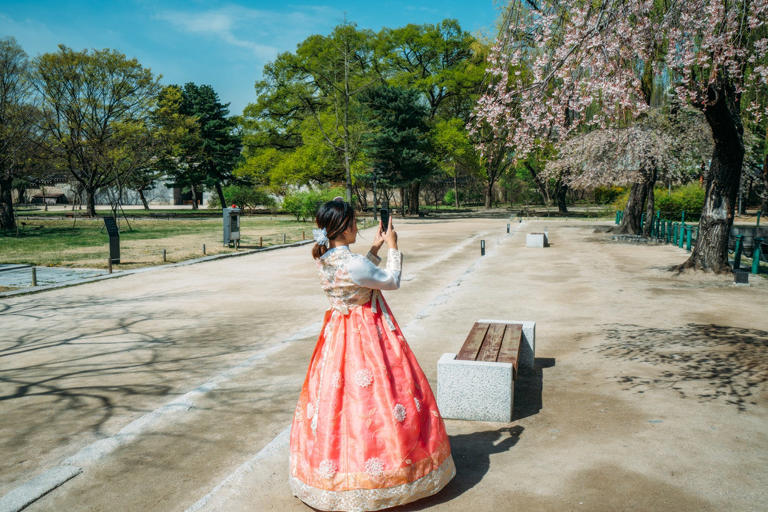

IMAGES
VIDEO
COMMENTS
How long is the drive from Tokyo to Kyoto? The direct drive from Tokyo to Kyoto is 283 mi (456 km), and should have a drive time of 4 hrs 38 mins in normal traffic.. If you're going on a road trip from Tokyo to Kyoto, we did the research for you and compiled some great stops along the way — with Yokohama, Nagoya, Hakone-machi, Fujikawaguchiko-machi, Kamakura, Hamamatsu, Shizuoka, Kawagoe ...
The path is a 2 km walk, which takes around 30 minutes—but leave time for temples and wandering. Nearest stop: Catch the bus Ginkakuji stop (numbers 5, 17 and 100) 3. Higashiyama District. Photo by Lily Crossley-Baxter. The narrow, winding streets of Higashiyama are exactly what you picture when you think of Kyoto.
Here are a few highlights to visit along your route: Chisuji Falls - Ribbon-like streams of water flow down a mossy rock face. Ōwakudani - An active volcanic crater with billowing steam and Mount Fuji views. Hakone Ropeway - A sky-high cable car carries you across the valley and down to Lake Ashi.
The Old Tokaidō Road was the main walking trail between Edo (the name for Tokyo during the Edo era, 1603-1868) and Kyoto, the former capital of Japan. It was an important — and probably quite busy — road for samurai, officials and merchants during that time. Along the road, there were posts, inns, temples and shrines at the service of ...
Taking the Shinkansen from Tokyo to Kyoto. From US$88.00 *. 2 hours and 15 minutes (fastest service) Buy a one-way ticket on Klook or Rakuten Travel Experiences, or a JR Pass in advance. The Tōkaidō Shinkansen connnects Tokyo and Kyoto (and terminates one stop further, at Shin-Osaka Station).
Tokyo to Kyoto by Bus. A one-way trip from Tokyo to Kyoto takes anywhere from 7 hours, with one-way fares from 3,500 yen for a discount bus up to 10,000 yen for a premium bus. You can get a Japan Bus Pass which reduces the costs and reserve a seat online at Japan Bus Online.
Japan Railways Shinkansen operates a train from Tōkyō Station to Kyōto every 20 minutes. Tickets cost $70-110 and the journey takes 2h 17m. Alternatively, JR Bus Kanto operates a bus from Shinjuku Expressway Bus Terminal to Kyōto Station Karasumaguchi once daily. Tickets cost $26-50 and the journey takes 7h 8m.
Getting from Tokyo to Kyoto by bus is a convenient travel option. The trip duration averages seven to nine hours. Ticket prices vary based on the company, class, and amenities but generally range from ¥3,600 to ¥16,000. Buses depart from Tokyo's travel hubs like Tokyo Station or Shinjuku Station and arrive at various locations in Kyoto ...
Kyoto is 283 miles (445 km) from Tokyo, but you can get from Tokyo to Kyoto in just over two hours if you travel on a high-speed shinkansen (bullet train). By air, the journey will take about three hours, including ground transportation. Driving and taking the bus are slower options; traveling from Tokyo to Kyoto by bus takes anywhere from 7.5 to 9.5 hours, and driving takes about 5.5 hours ...
Day 4: Travel to Kyoto, Explore Downtown Kyoto Take the shinkansen from Tokyo to Kyoto. The journey takes around 2.5 hours. For details, see our How to Travel from Tokyo to Kyoto page. You'll probably have some time after arriving in Kyoto to explore. We recommend checking out the downtown area on this day. Day 5: Kyoto: Southern Higashiyama
Here's a sample itinerary for a drive from Tokyo to Kyoto. If you're planning a road trip to Kyoto, you can research locations to stop along the way. Make sure you check road conditions to double check the weather. Find the best hotels, restaurants, and attractions based on the most talked about places recommended by Trippy members.
Japan Itinerary: 7 Days to Explore Around Tokyo and Kyoto. Welcome to the ultimate 7-day itinerary for Tokyo and Kyoto, carefully crafted for you. Pack your travel hats and get ready for a week-long extravaganza as we take you on a journey through the heart of Japan. This itinerary is a delightful blend of bustling metropolises, serene shrines ...
See our full Tokyo Two-Day Itinerary for details. Day 4: Travel to Takayama. Take the shinkansen from Tokyo to Nagoya and change to a Hida Wide View express train to Takayama. The total journey takes 4 hours, 20 minutes, and costs Y13,930. The Japan Rail Pass covers this leg.
Paid Partnership with. Taking the New Golden Route through Hokuriku might be more leisurely than a direct bullet train from Tokyo to Kyoto, but you'll find the time you spend in each of Hokuriku's distinct prefectures time well spent. Japan Rail even offers a special Hokuriku Arch Pass offering 7 days of unlimited travel between many ...
The closest airport to Kyoto is Osaka's Itami Airport, about one hour by bus from central Kyoto (more details).Most flights connect Itami Airport with Tokyo's Haneda Airport, with just a few serving Tokyo's Narita Airport.Flight duration is one hour. The regular one way fare is around 31,000 yen, but discount tickets are usually available for around 10,000 to 15,000 yen.
10-Day Round Trip from Tokyo to Kyoto. Tokyo and Kyoto are two of the must-see places in Japan and are separated by an hour plane ride or a 2.5-hour bullet train ride. However, in between lies so much that would be missed traveling by plane or train. Traveling by campervan is the perfect way to get the most out of your trip to Japan with ...
The Takeaway. The shinkansen (bullet train) is the best way to travel between Tokyo and Kyoto. It takes around 2 hours and 15 minutes and costs Y13,080 between Tokyo and Kyoto (non-reserved seat). You don't need to reserve seats on the shinkansen if you travel outside of peak travel hours and outside of peak travel seasons.
Japan Railways Shinkansen operates a train from Kyōto to Tōkyō Station every 15 minutes. Tickets cost $70-100 and the journey takes 2h 18m. Alternatively, JR Bus Kanto operates a bus from Kyōto Station Karasumaguchi to Shinjuku Expressway Bus Terminal once daily. Tickets cost $25-50 and the journey takes 7h 26m.
Here are the fastest ways to get from Tokyo to Kyoto: 1. Bullet train or shinkansen. Go from Tokyo to Kyoto in a flash while aboard the Shinkansen! Credits: Fikri Rasyid on Unsplash. Taking the Nozomi bullet trains on the Tokaido Shinkansen Line is definitely the fastest way to travel between Tokyo and Kyoto. The one-way trip from Tokyo Station ...
Don't overlook Narita Airport too—just consider the 90-minute, AUD10.63 Tokyo-Narita trek. Book a Flight to Kyoto. Touching down at Kansai Airport, the journey kicks off with a brisk 75-minute ride on the JR Haruka Ltd. Express, priced at AUD 38.61, but online steals drop it to AUD 19.14. For short-term visitors, the ICOCA & Haruka package ...
Here's a sample itinerary for a drive from Kyoto to Tokyo. If you're planning a road trip to Tokyo, you can research locations to stop along the way. Make sure you check road conditions to double check the weather. Find the best hotels, restaurants, and attractions based on the most talked about places recommended by Trippy members.
Weekly Events. Kyoto Friday Road Show and Ghibli Exhibition. Taue-sai Festival. Kyoto Heian Antique Market. Recurring Events. Gion Corner. Nidec Kyoto Tower. Toei Kyoto Studio Park. Japan Wonder Travel Tours in Kyoto.
Funaoka Onsen. Have a soak at this retro bathhouse, where you will find Japan's first electric bath, tiling from Spain, and wood carvings representing the Japanese invasion of Manchuria. Kyoto, Japan.
SHIBUYA SKY, located at 299m above ground, looks out across the Tokyo landscape. If you want to experience Shibuya's culture in a bustling, lively atmosphere, start in front of the famous Hachiko statue and walk down Center-Gai Street . Or to see the newest side of Shibuya, try Shibuya Scramble Square or Shibuya Stream.
Himeji . Home to a UNESCO World Heritage Site castle, Himeji is worth a special trip for the Himeji-jo castle alone.Widely considered to be the finest example of 17th-century feudal-era Japanese ...
Summary: Kyoto to Tokyo via Shinkansen. Travel time: 2 hours 10 minutes to 4 hours (depending on type of train) Depart from: Kyoto Station Cost: ~¥13,320 (non-reserved seat), ~¥14,250 (reserved seat in an ordinary car), ~¥18,720 (reserved seat in a green car) Pros: Fast, frequent, comfortable, and you can enjoy the scenery on the train.
From Cabo San Lucas to beaches along the Riviera Maya in areas like Tulum, Cancun and Playa del Carmen, Mexico is the perfect solo travel destination for rest and relaxation. 7. Japan. As one of the safest countries in the world, Japan is one of the best places to visit for solo travelers. Top cities in Japan include Tokyo, Osaka, Sapporo, and ...
Whether the avid traveler is a history buff, a food enthusiast, or a nature lover, Japan is the perfect place for their visit in 2024. Explore Kinkaku-ji at Kyoto. Enjoy Hanami in Tokyo. Feed the ...
Seoul, South Korea. The cherry blossom spectacle at Yeouido Hangang Park in Seoul is a must-see, and it doesn't have the same influx of foreign travelers that you'll find in Tokyo, so you can ...